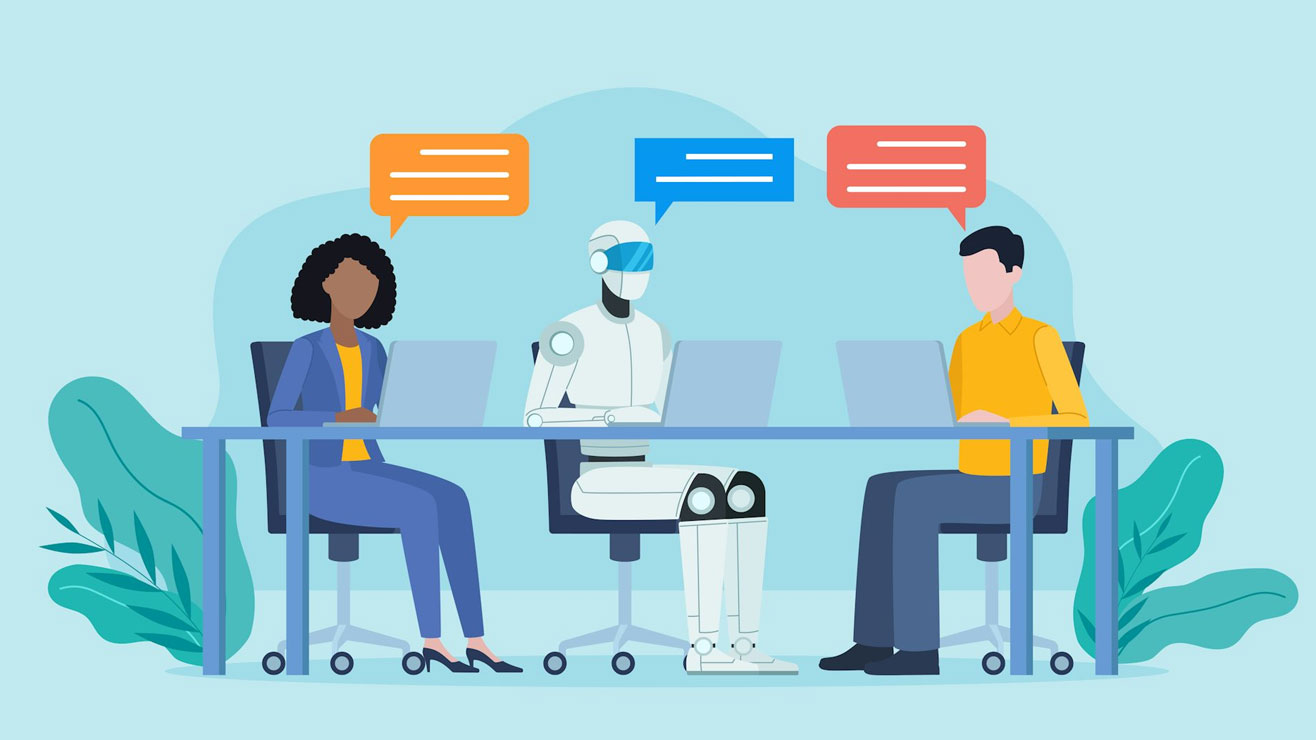Best sleep headphones 2025: From tiny earbuds and snuggly headbands to pillow speakers
Whether you want to block out the noise or stay aware of your surroundings, these are the best sleep headphones we recommend, all tried and tested.
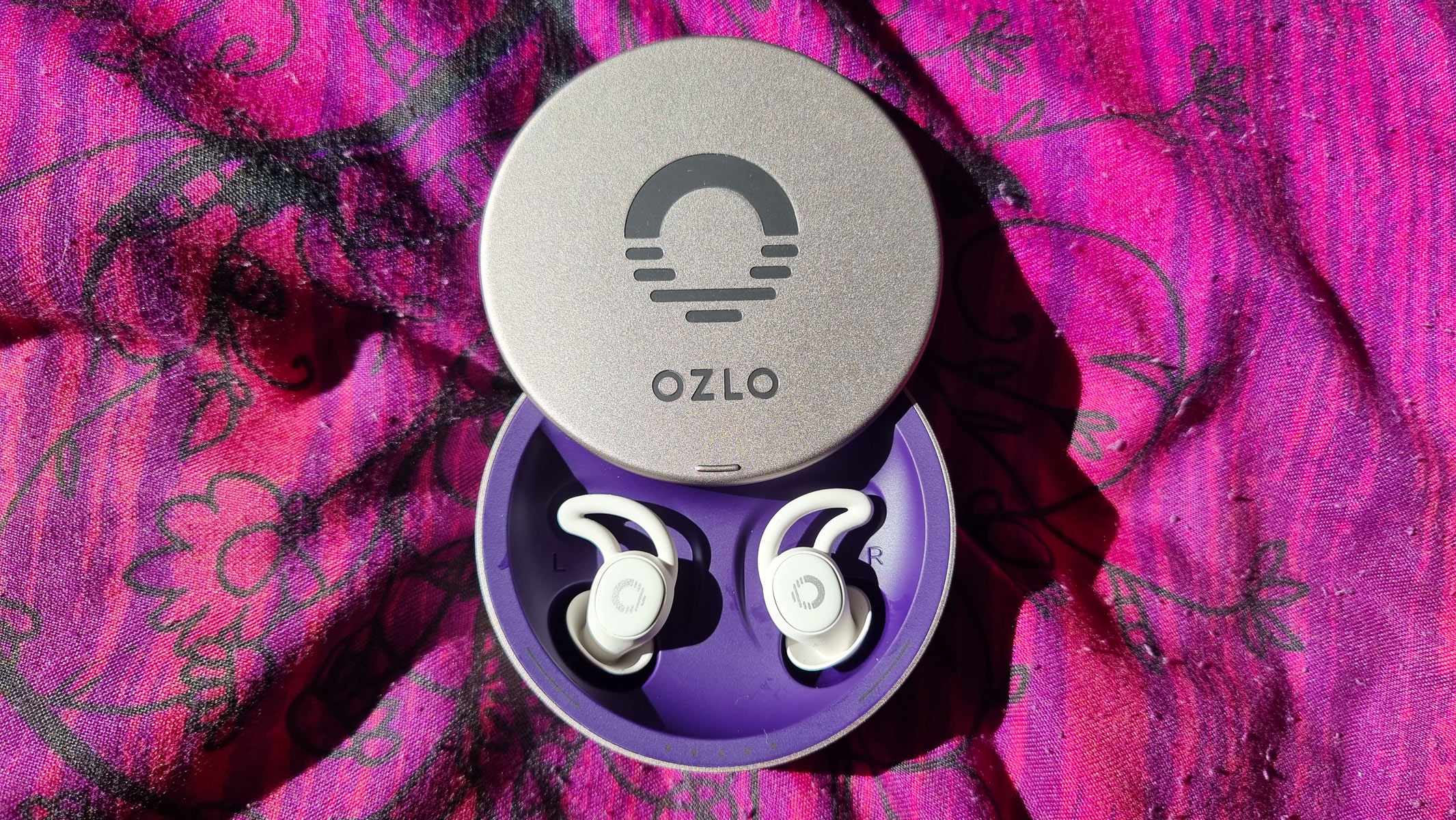
Sleep headphones are audio devices designed to help you fall asleep and stay asleep more easily. There are two main types: Tiny and squishy earbuds (such as our favorite Ozlo Sleepbuds), or bigger headbands with built-in speakers (like the excellent AcousticSheep SleepPhones V), for example. Both tend to prioritize comfort and effective noise cancellation, unlike 'regular' headphones that focus primarily on sound quality, battery life and smart features. Many sleep headphones also come with pre-loaded soundscapes, such as nature sounds, that can help your body relax.
As Sam Sadighi, a psychologist and certified sleep practitioner, told Live Science: "Sleep headphones aid uninterrupted sleep by masking disruptive external noises, such as snoring partners or city traffic, and when paired with calming soundscapes, white noise, or guided meditations, they can also support relaxation and make it easier to drift off. Sleep headphones can also provide a helpful distraction for individuals experiencing bedtime anxiety or an overactive mind." For more information on the pros and cons of sleep headphones, scroll down to the FAQs section.
Sleep headphones are notoriously difficult to assess objectively, which is why we tried to be as fair and balanced in our testing process as possible. We looked at their design, features, ease of use and overall value for money, and shared our personal experiences with the products. Below, you will find the six sleep headphones that impressed us the most — we hope they will work well for you, too. Some of these models have already been discounted this holiday season. You can also pair them with one of the best sleep trackers for detailed insights into your bedtime routine.
The quick list
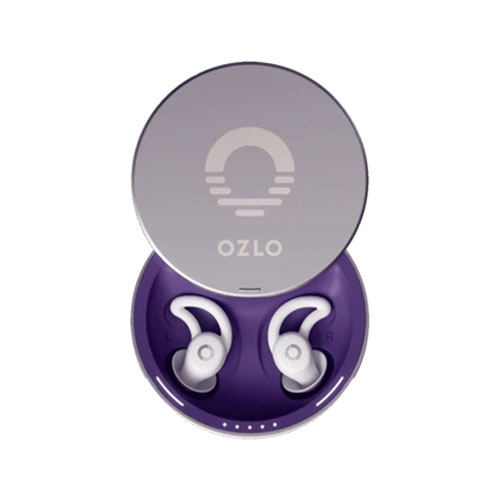
Best sleep earbuds
These sleep earbuds outshine their competitors with an ultra-comfortable fit, impressive passive noise cancellation and genuinely relaxing soundscapes. Expensive, but well worth the price.

Best sleep earbuds for noisy conditions
Innovative smart earbuds with active noise cancellation that can easily block up to 30 dB of snoring, barking and other common night-time noises.
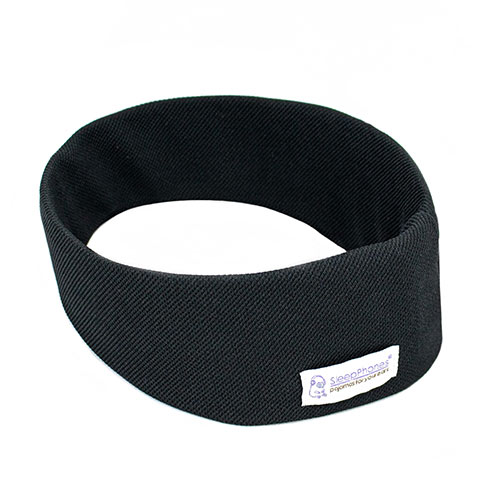
Best sleep headphones
These sleep headphones hit the sweet spot: they are cozy, highly customizable and user-friendly, and they deliver good sound quality and a relatively long battery life.
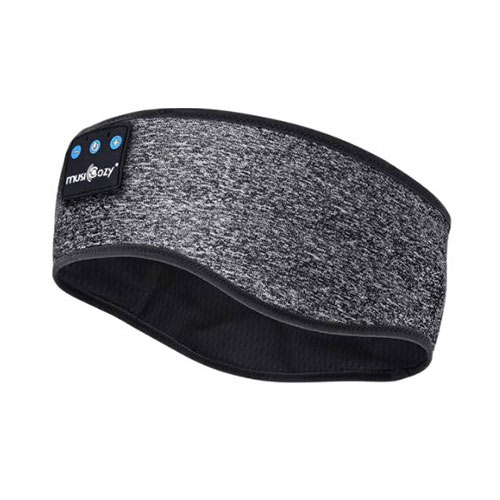
Best on a budget
These sleep headphones cost less than $26, but they come with surprisingly great-sounding speakers, a workout-friendly headband and a built-in microphone.
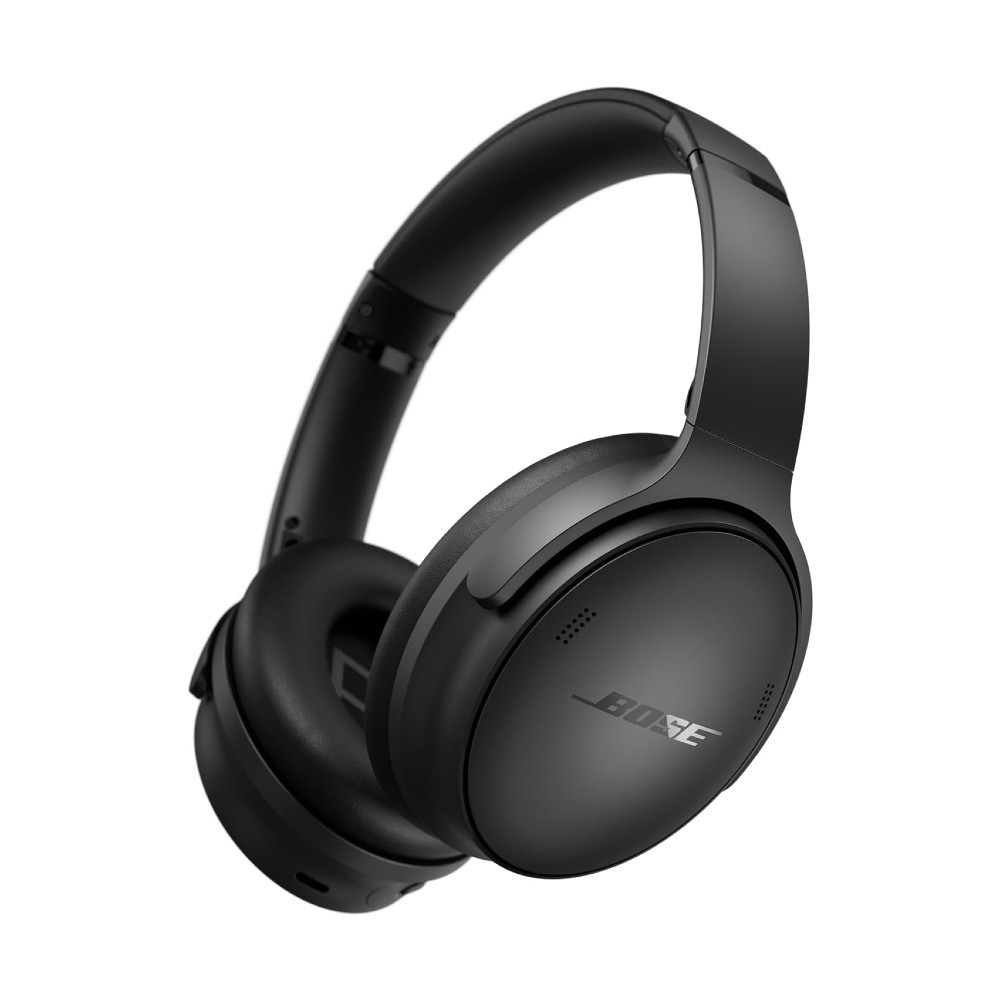
Best for napping on a plane
Exceptionally comfortable to wear and efficient at blocking low-frequency sounds, these headphones are our go-to option for napping tens of thousands of feet above the ground.
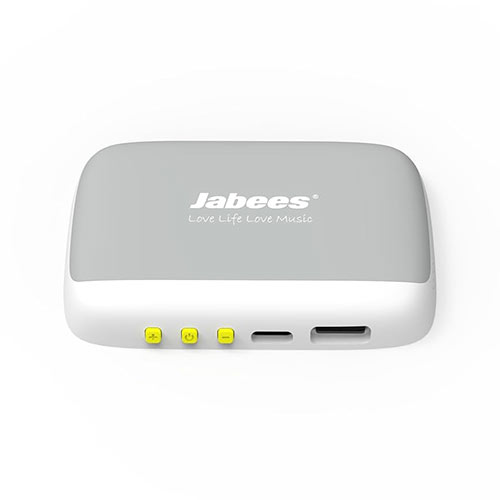
Best alternative to sleep headphones
Sensitive ears? Need to stay aware of your surroundings? This under-pillow bone conduction speaker may be the alternative you are looking for.
The best sleep headphones we recommend in 2025
Why you can trust Live Science
Best sleep earbuds

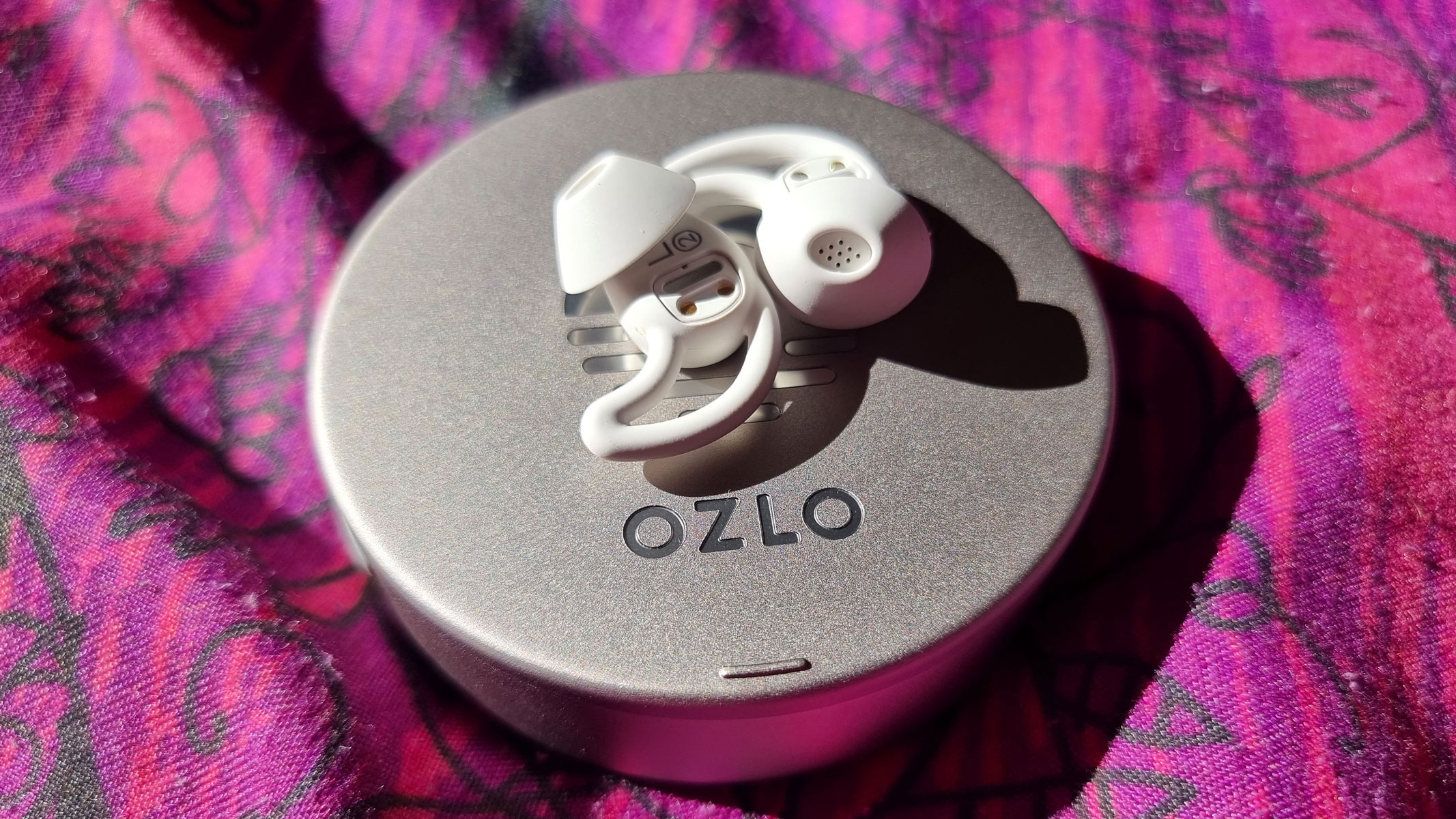
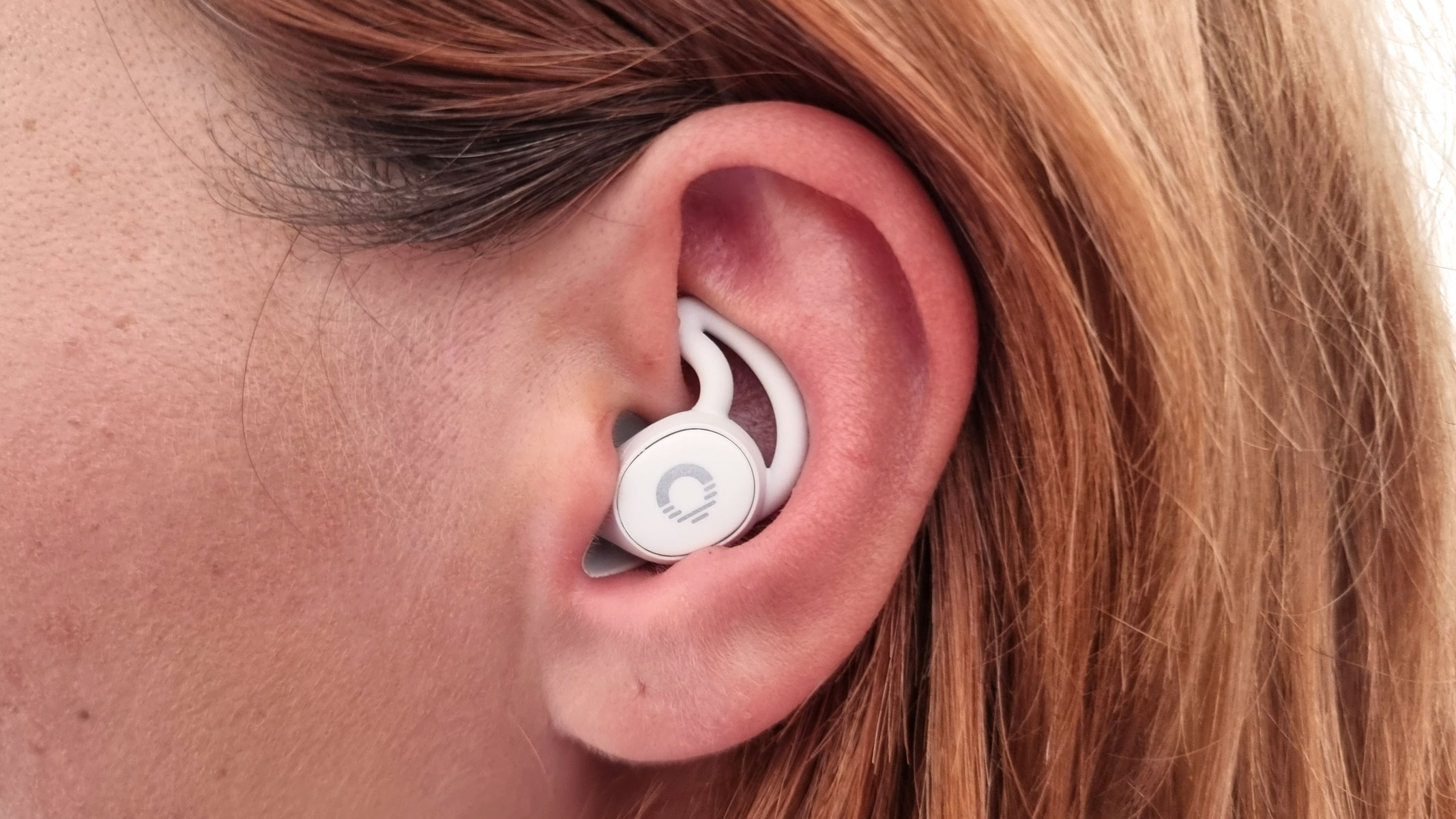
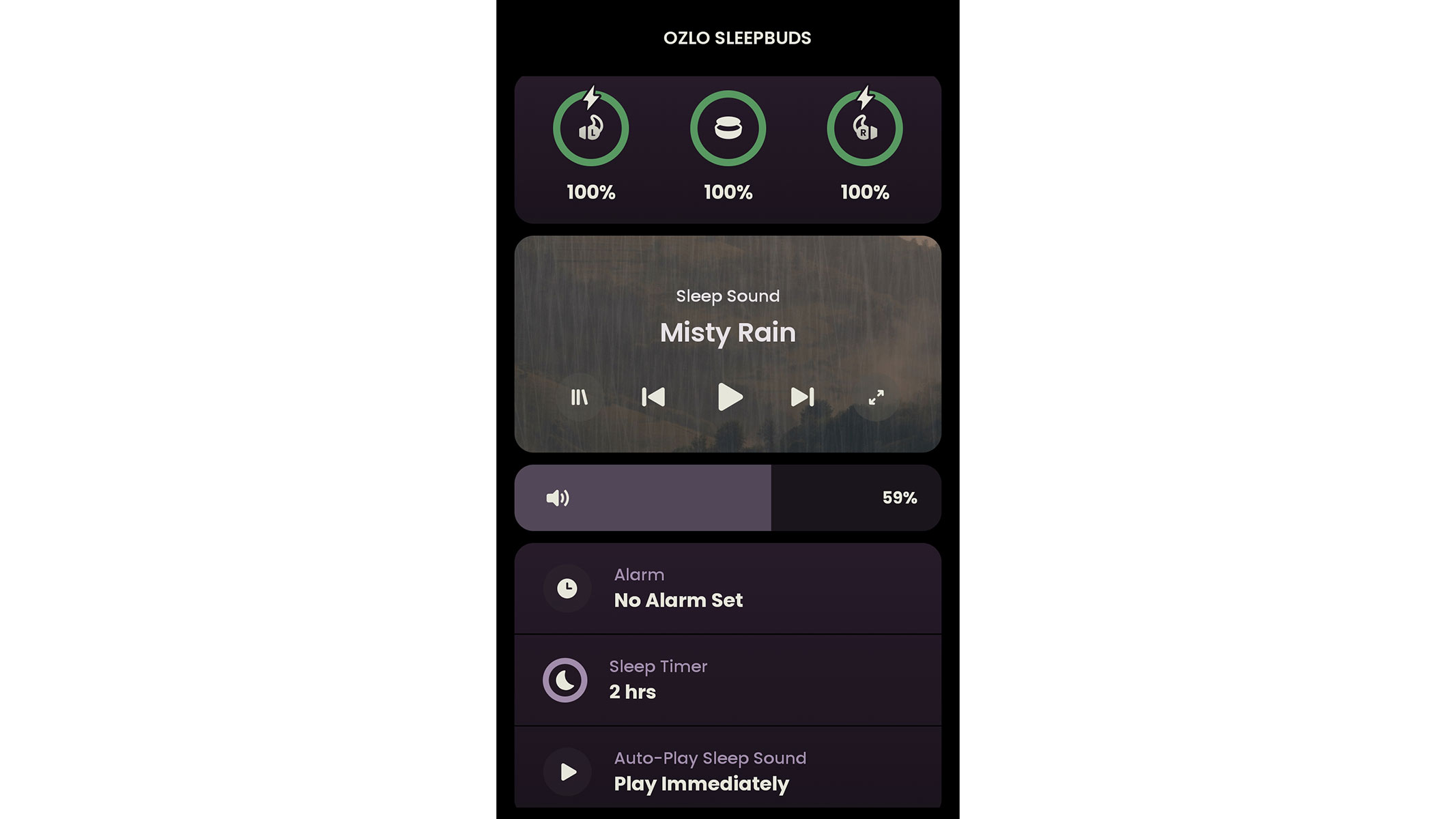

Ozlo Sleepbuds
Our expert review:
Specifications
Reasons to buy
Reasons to avoid
✅ You are an audiophile: These are the best-sounding earbuds in this guide.
✅ You are a restless sleeper: These earbuds stay in your ears all night.
✅ You like to sleep on the side: They are not as comfortable as over-ear headphones, but they will not cause ear soreness, either.
❌ You sleep in noisy conditions: While these earbuds are good at blocking external sounds, they do not have active noise cancellation.
❌ You want daytime headphones: It may not always be possible to keep the earbuds and the case in the required Bluetooth range.
❌ You are on a budget: The Ozlo Sleepbuds cost $349.
🔎 Ozlo Sleepbuds: App-connected, highly effective at blocking out unwanted sounds and ultra-comfortable to wear, the Ozlo Sleepbuds are among the best sleep headphones on the market. If only they were more affordable, or had more features to justify their relatively high price, they would have scored a full five stars. ★★★★½
The Ozlo Sleepbuds take the well-deserved top spot. They won us over with their secure, ultra-comfortable fit, great sound quality and a dedicated app filled with genuinely relaxing soundscapes. These sleep earbuds are relatively small and squishy, but they do a surprisingly good job of blocking out unwanted sounds, and they can last up to 10 hours on a single charge — longer than most similar products we tested. True, the Ozlo Sleepbuds cost a steep $349 and are rarely on sale, making them the most expensive option in this guide, but we still think they can provide enough value to outperform their competitors.
For starters, the Ozlo Sleepbuds made a tangible difference to the quality of our sleep, and that is not something we can confidently say about most other sleep earbuds. We suspect that it is partially down to the skillfully composed soundscapes available on the Ozlo app. Whenever we listened to them while we were falling asleep, we woke up the following morning feeling more refreshed than usual — and we have receipts to prove it. Both of our trusted fitness trackers, the Oura Ring Gen 4 and the Whoop MG, have detected fewer sleep disturbances and slightly longer bouts of deep sleep (the most restorative of sleep stages).
That said, we could not find any scientific papers that would help us explain this, even though Ozlo proudly proclaimed on its website that its "sleep technology is clinically proven to help you fall asleep faster and stay asleep longer." As such, we would advise you to take our experiences with a pinch of salt. Still, whether it was just a placebo effect or a genuine improvement to the quality of sleep, it does not change the fact that Ozlo Sleepbuds are an exceptionally well-made product that would suit most people. These sleep earbuds are soft enough for side sleepers, with enough tips and wing sizes to snugly fit most ears, and with a good degree of audio depth and richness to satisfy audiophiles.
There are some downsides to the Ozlo Sleepbuds, though. For example, you have to keep them within 10 feet of the charging case and 30 feet of your mobile device. That is because these earbuds rely on Bluetooth Low Energy, a technology that reduces power use and allows for their ultra-compact design, but vastly limits their connectivity range. This means that Ozlo Sleepbuds may be somewhat impractical to use during daytime activities. Moreover, these earbuds do not feature active noise cancellation, so they may not perform too well in noisy conditions, and as we mentioned already, they are relatively expensive.
Attributes | Notes | Rating |
|---|---|---|
Comfort | Secure-fitting, comfortable to wear and suitable for side sleepers. | ★★★★★ |
Performance | Great sound quality and long battery life. Limited Bluetooth range. | ★★★★½ |
Functionality | Well-designed app with sleep-related features. No ANC or on-body controls. | ★★★★ |
Best sleep earbuds for noisy conditions
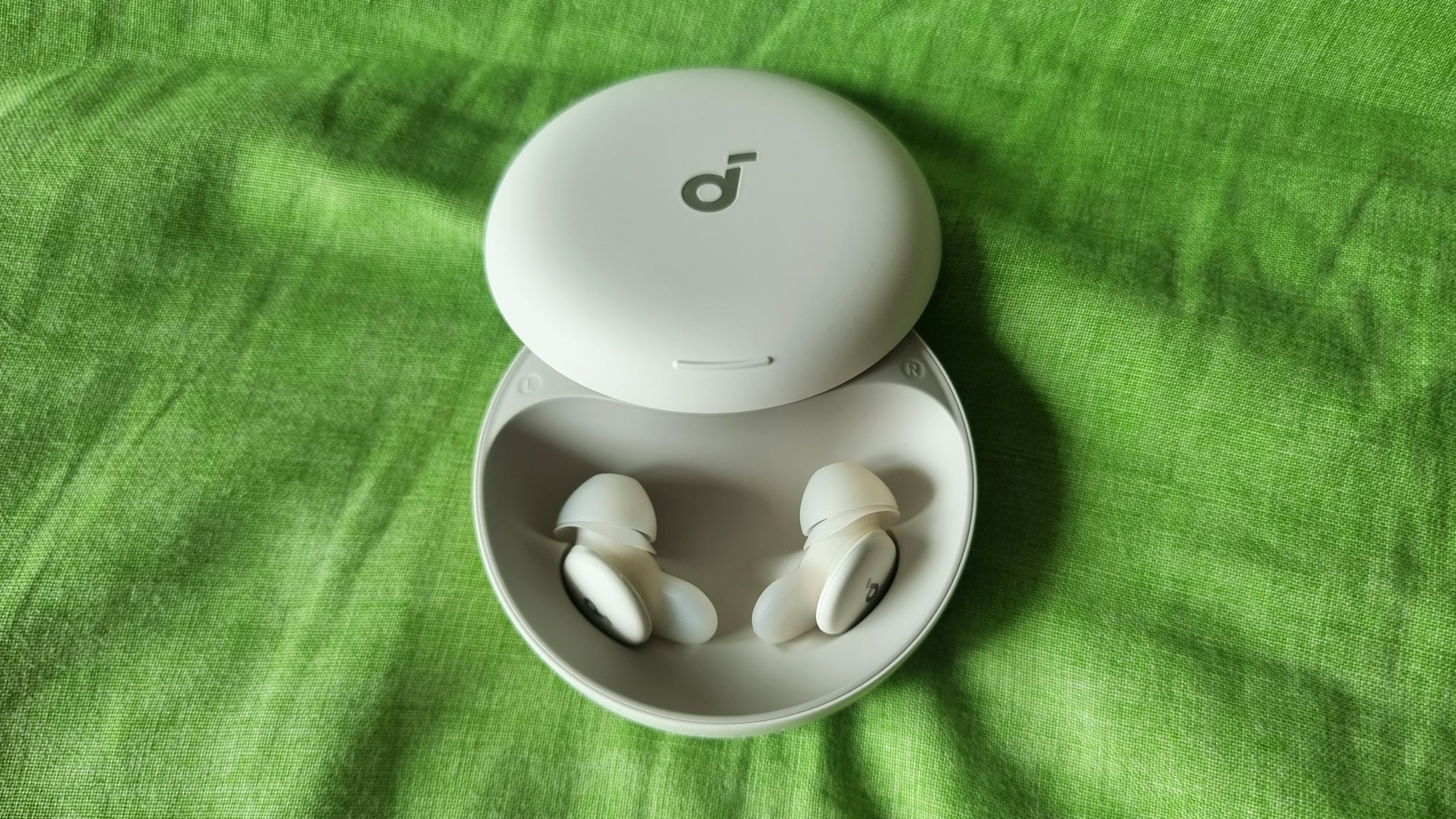
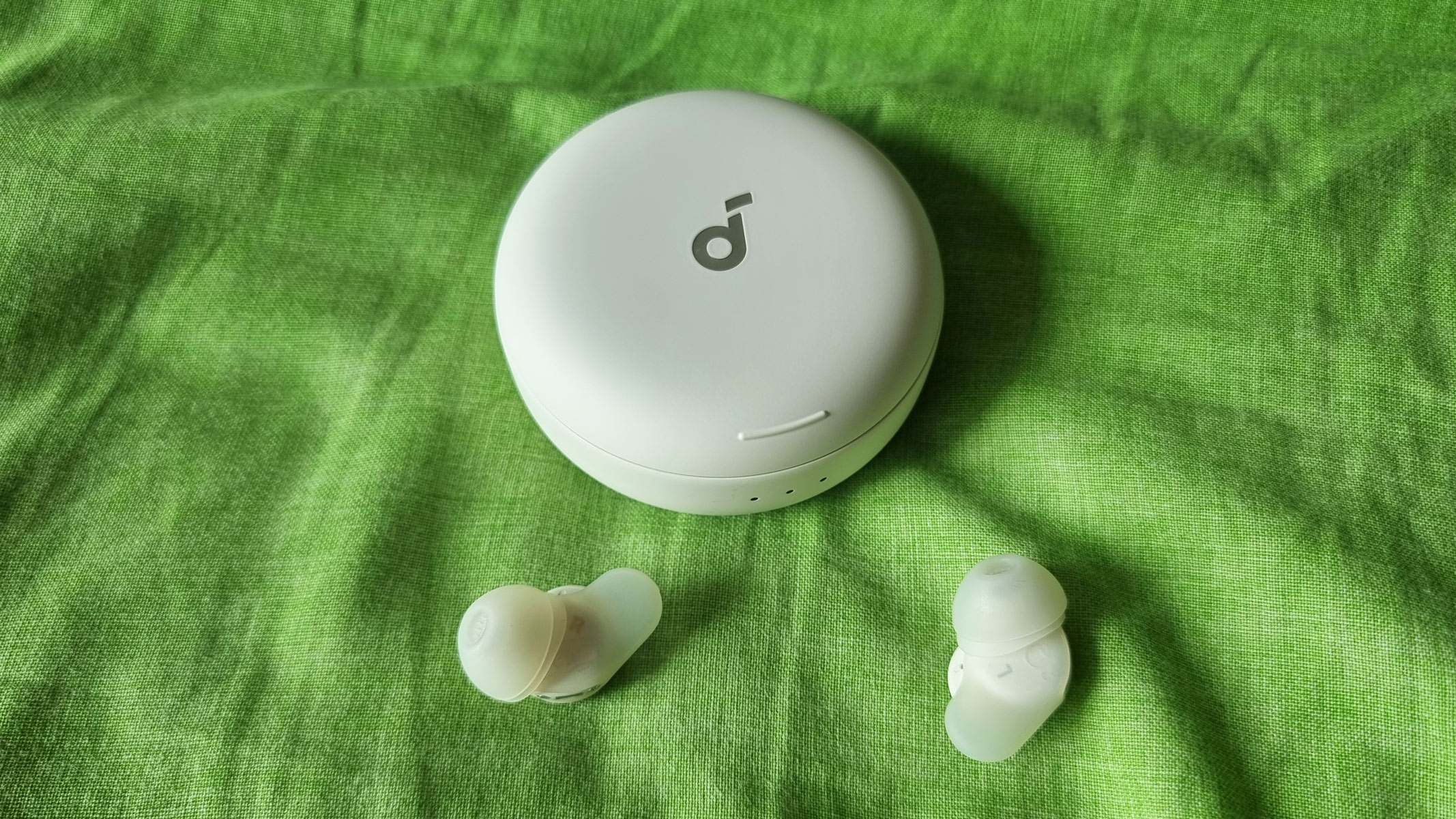
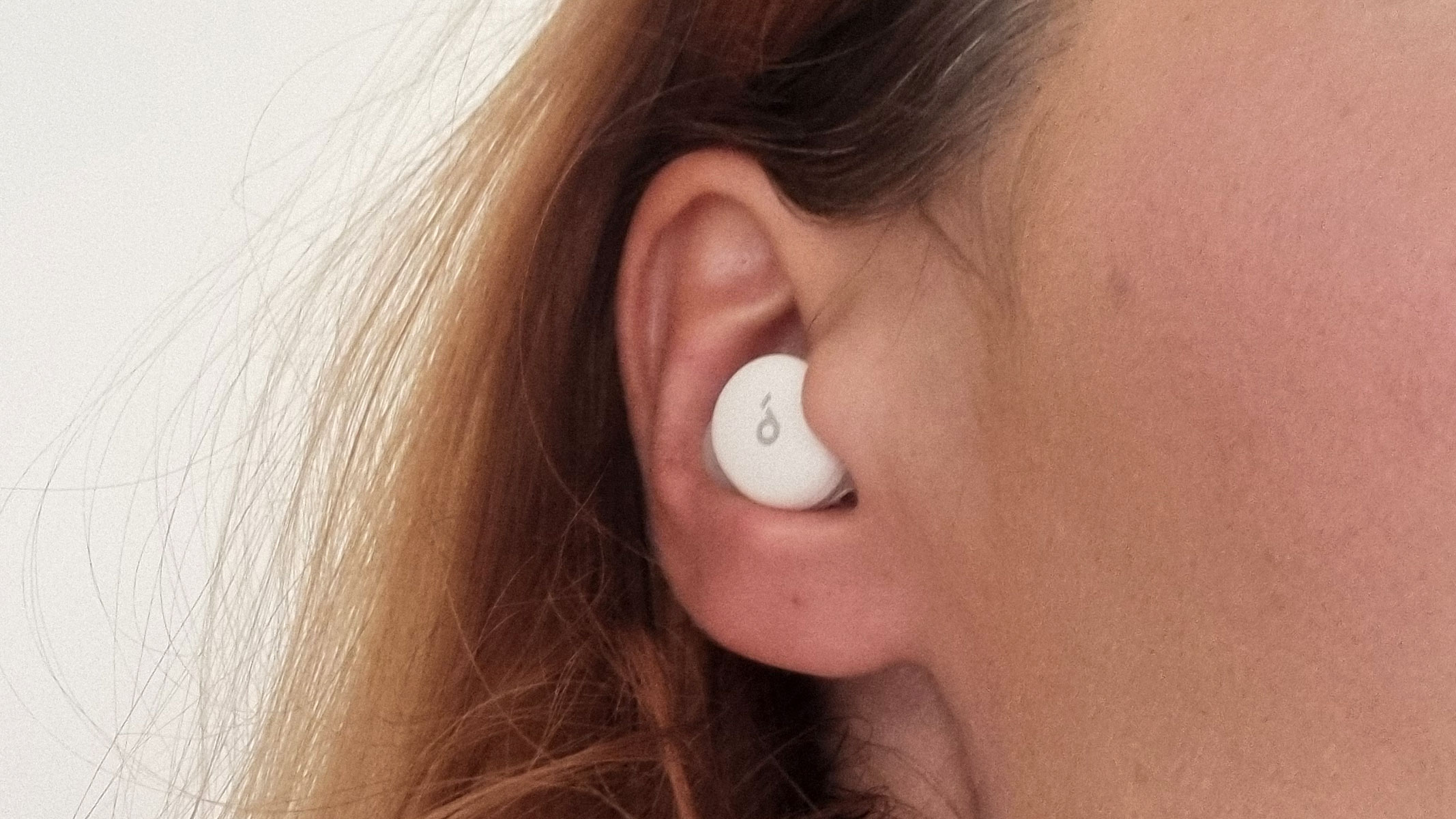
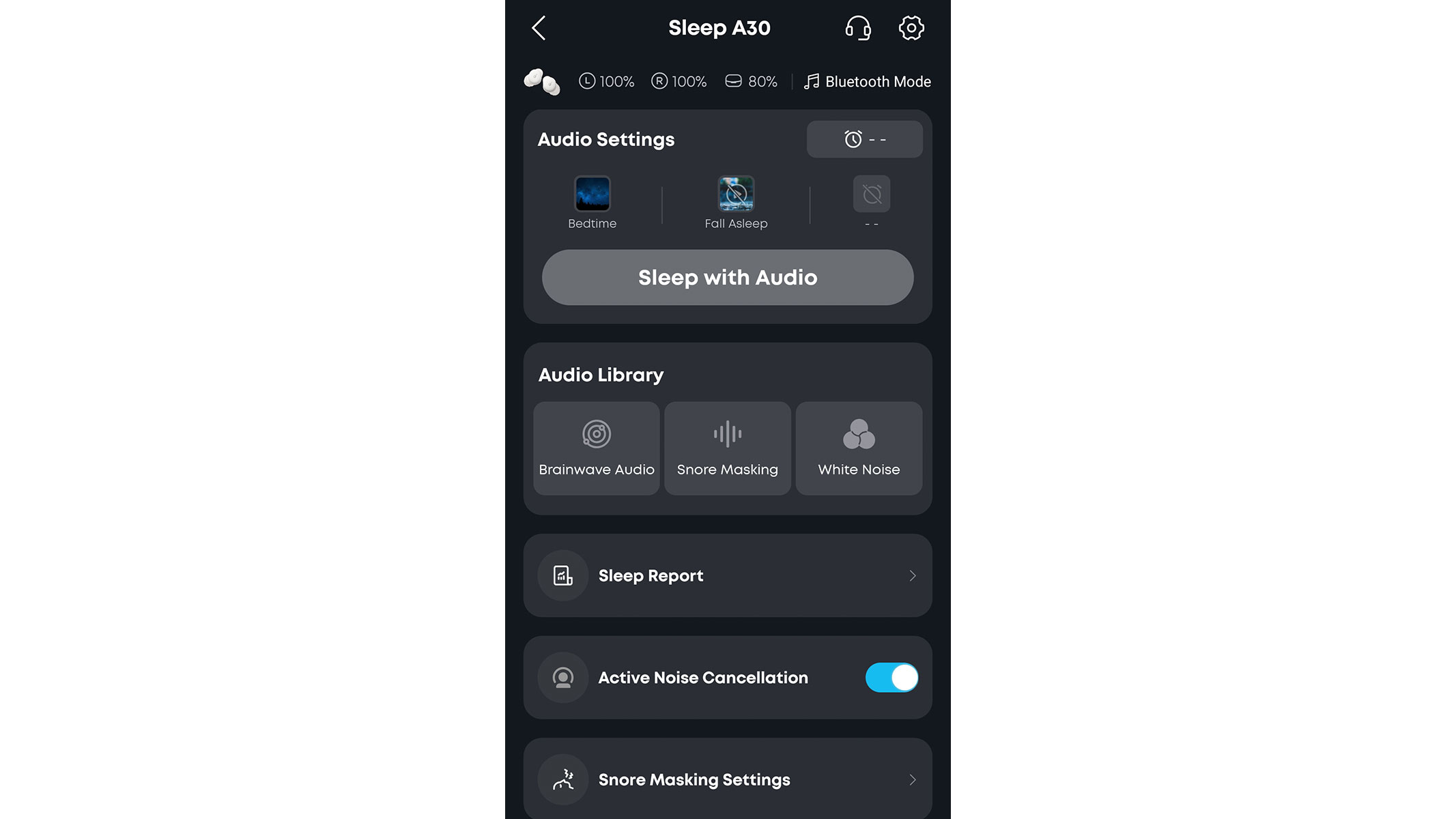
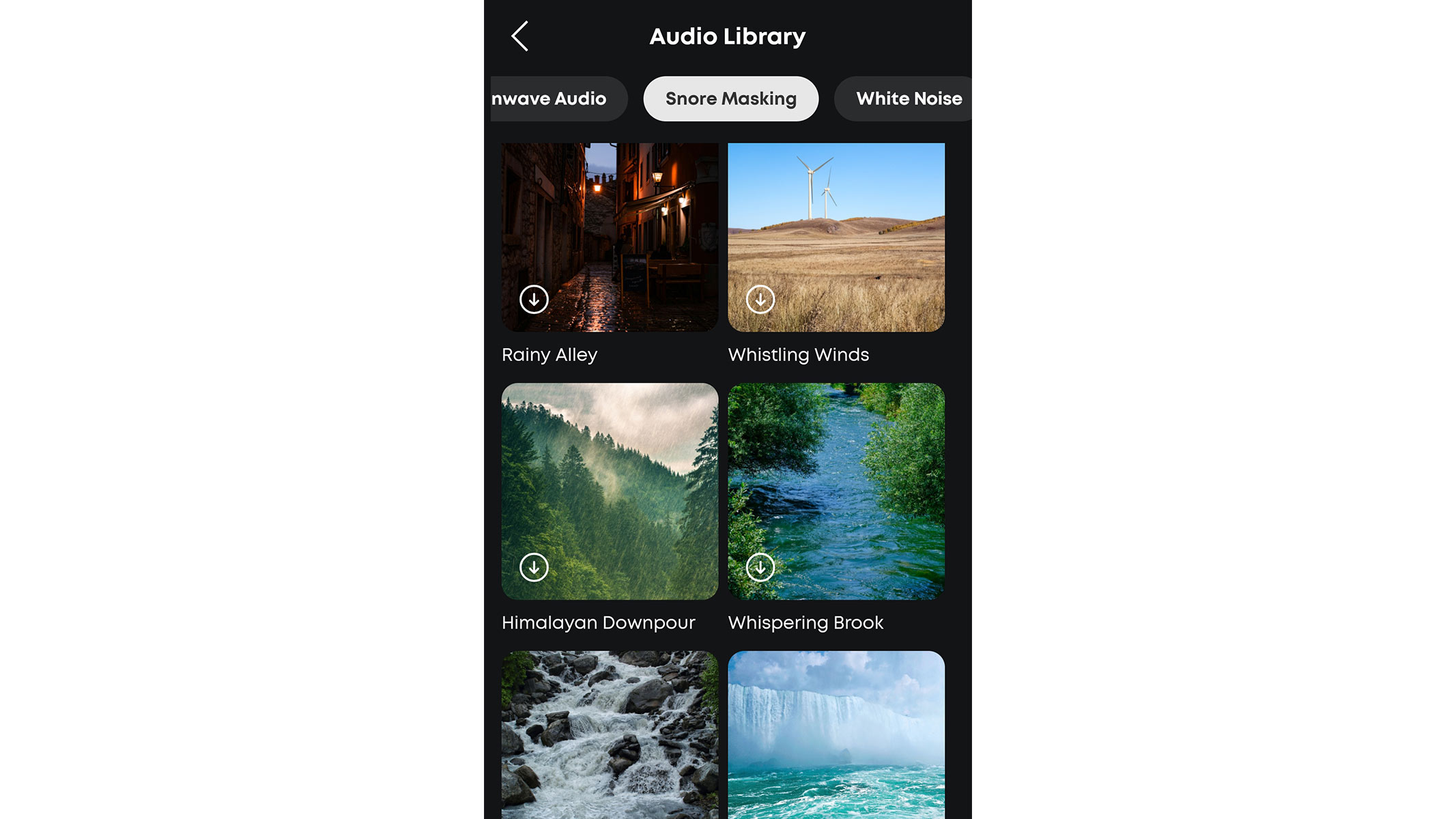
Soundcore Sleep A30
Our expert review:
Specifications
Reasons to buy
Reasons to avoid
✅ Your partner snores: These earbuds feature a novel Adaptive Snore Masking technology (yes, you read that right).
✅ You are a light sleeper: They effectively block up to 30dB of external noise.
✅ You want a white noise machine: The Soundcore app is jam-packed with sleep soundscapes.
❌ You are on a budget: They cost around $229.
❌ You tend to sleep for long periods: The active noise cancellation can drain the battery fast.
❌ You have very sensitive ears: While comfortable to wear, they may be too bulky for some side sleepers.
🔎 Soundcore Sleep A30: These smart sleep earbuds with active noise cancellation deliver on their promises: they are comfortable to wear, efficient at blocking out external noises and good at helping you wind down before sleep. However, the Soundcore Sleep A30 underwhelms with short battery life and a relatively rigid design. ★★★★
Most sleep headphones can help you block external sounds to some degree, but only a handful of them are designed to perform in very noisy environments. The Soundcore Sleep A30 is one of those rare exceptions. Unlike most other sleep earbuds out there, they feature active noise cancellation and novel sound masking features that can block up to 30 dB of noise and help you get a more restful shuteye. Your snoring spouse, barking pets or traffic outside will no longer ruin your sleep, and we can attest to that.
The Soundcore Sleep A30 sleep earbuds are smart in the full sense of the word. They come with an exceptionally robust and advanced sleep app, with the biggest selection of sleep soundscapes and seemingly the most advanced sleep-tracking features of all the products mentioned in this guide. For example, the A30 are the only sleep earbuds we tested that can detect your partner's snoring, analyse its volume and frequency, and then generate appropriate noise-masking audio to block it out. Sounds like a gimmick? We thought so too, but it does seem to do the trick. While we can't say for sure if our partner did actually snore during testing, we did not hear anything at all, either. On the contrary, we enjoyed a genuinely peaceful sleep.
The design of these sleep buds, however, is a hit-and-miss. On the plus side, the Soundcore Sleep A30 features adjustable tap controls and four tip sizes, making them relatively easy to customize. We also found these sleep earbuds quite soft and comfortable to wear. That said, they did not feel as flexible, snuggly and secure-fitting as the Ozlo Sleepbuds. Some side sleepers and people with sensitive ears may still consider the Sleep A30 too bulky and rigid.
Battery life is another issue. Active noise cancellation tends to use up more energy than passive noise cancellation, and that is also the case with the Soundcore Sleep A30. While these sleep airbuds claim up to nine hours of continuous listening on a single charge, this only applies when you play app-based soundscapes at a 50% volume. If you stream your own audio, this drops to just 6 hours.
Lastly, the price. The Soundcore Sleep A30 costs roughly $229, making it one of the most expensive options in this guide.
Attributes | Notes | Rating |
|---|---|---|
Comfort | Comfortable to wear, with a relatively secure fit. May be too bulky and rigid for side sleepers. | ★★★★ |
Performance | Powerful ANC. Acceptable sound quality. Short battery life. | ★★★½ |
Functionality | Jam-packed with advanced features. | ★★★★½ |
Best sleep headphones
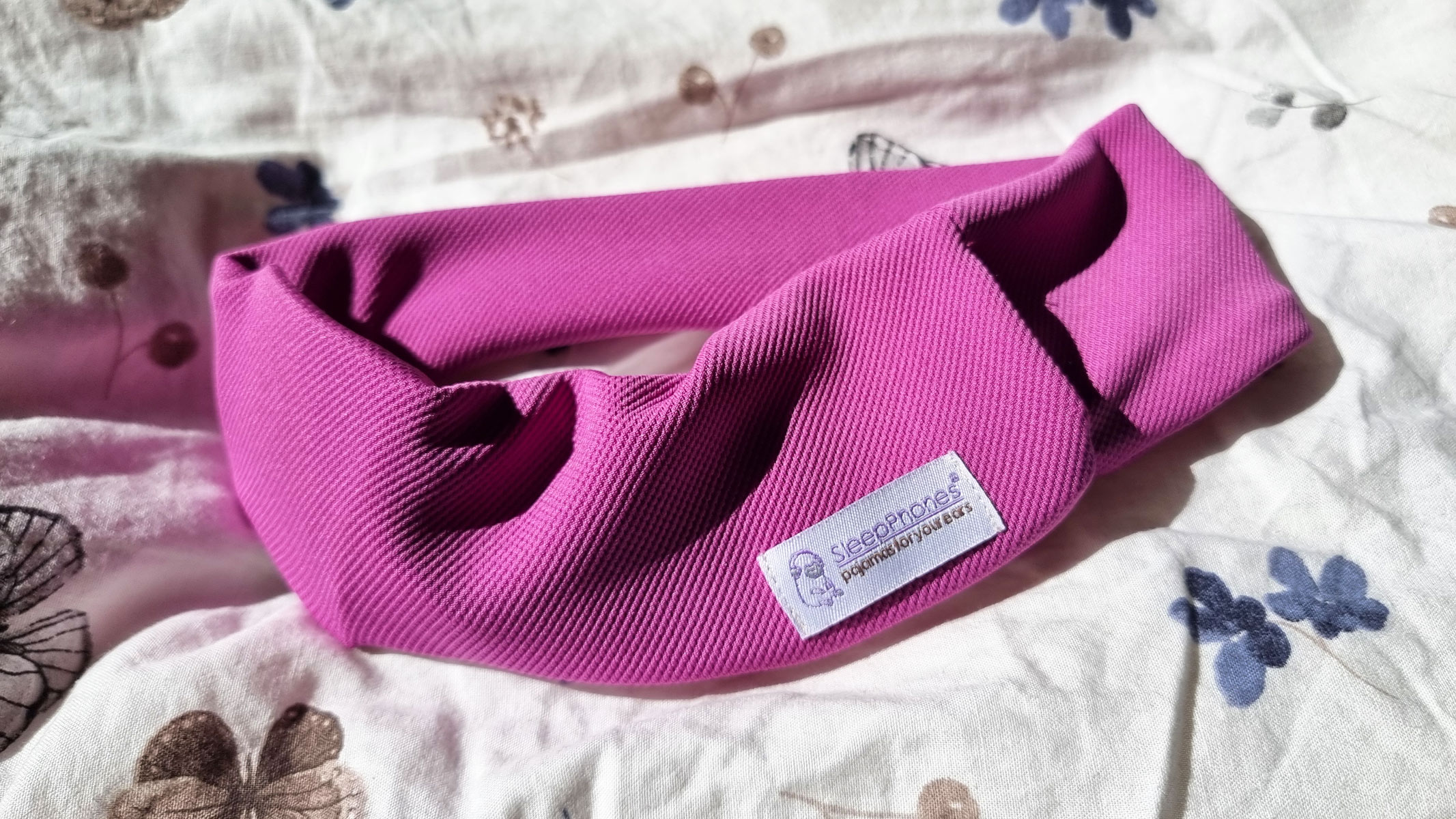
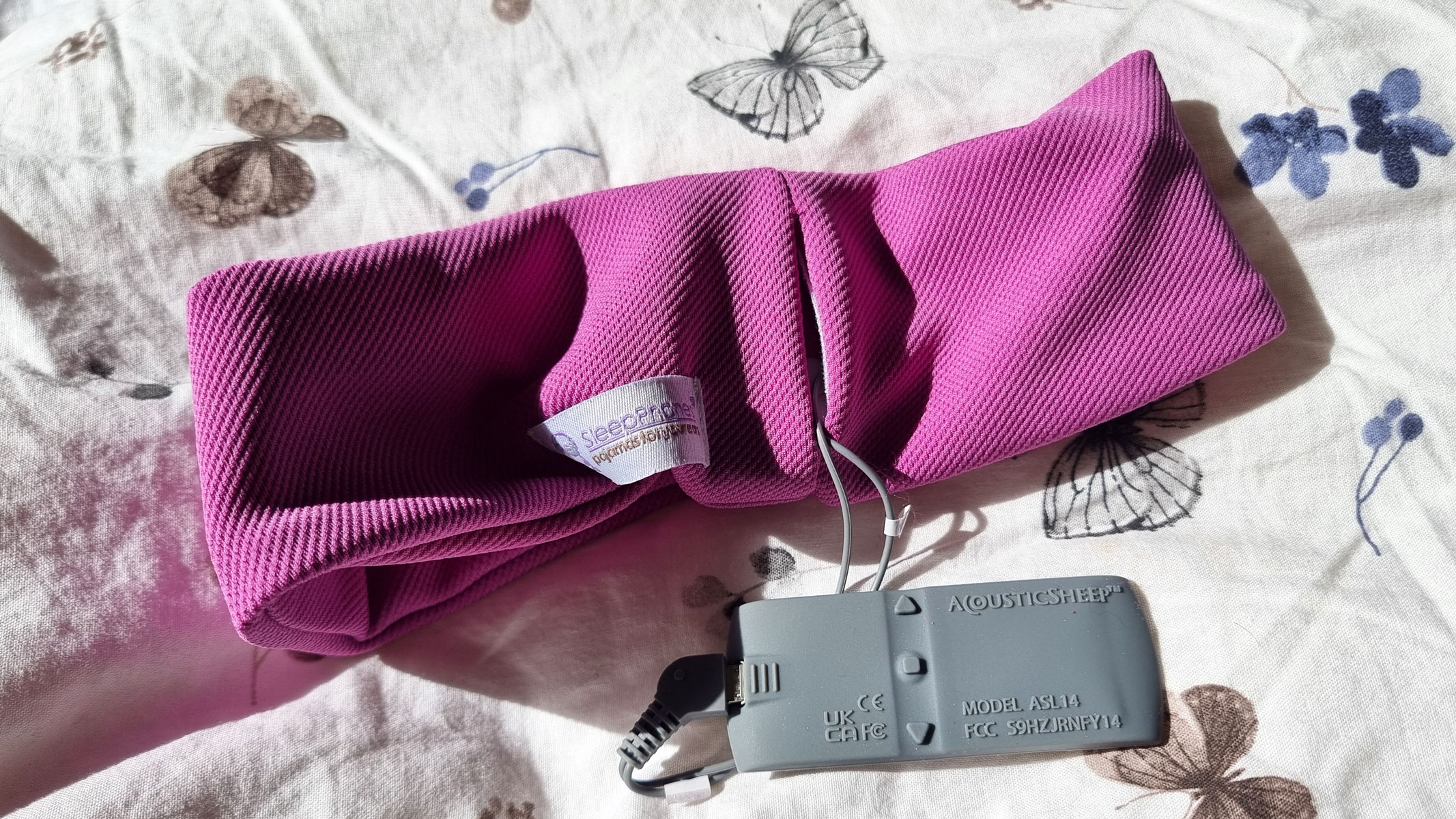

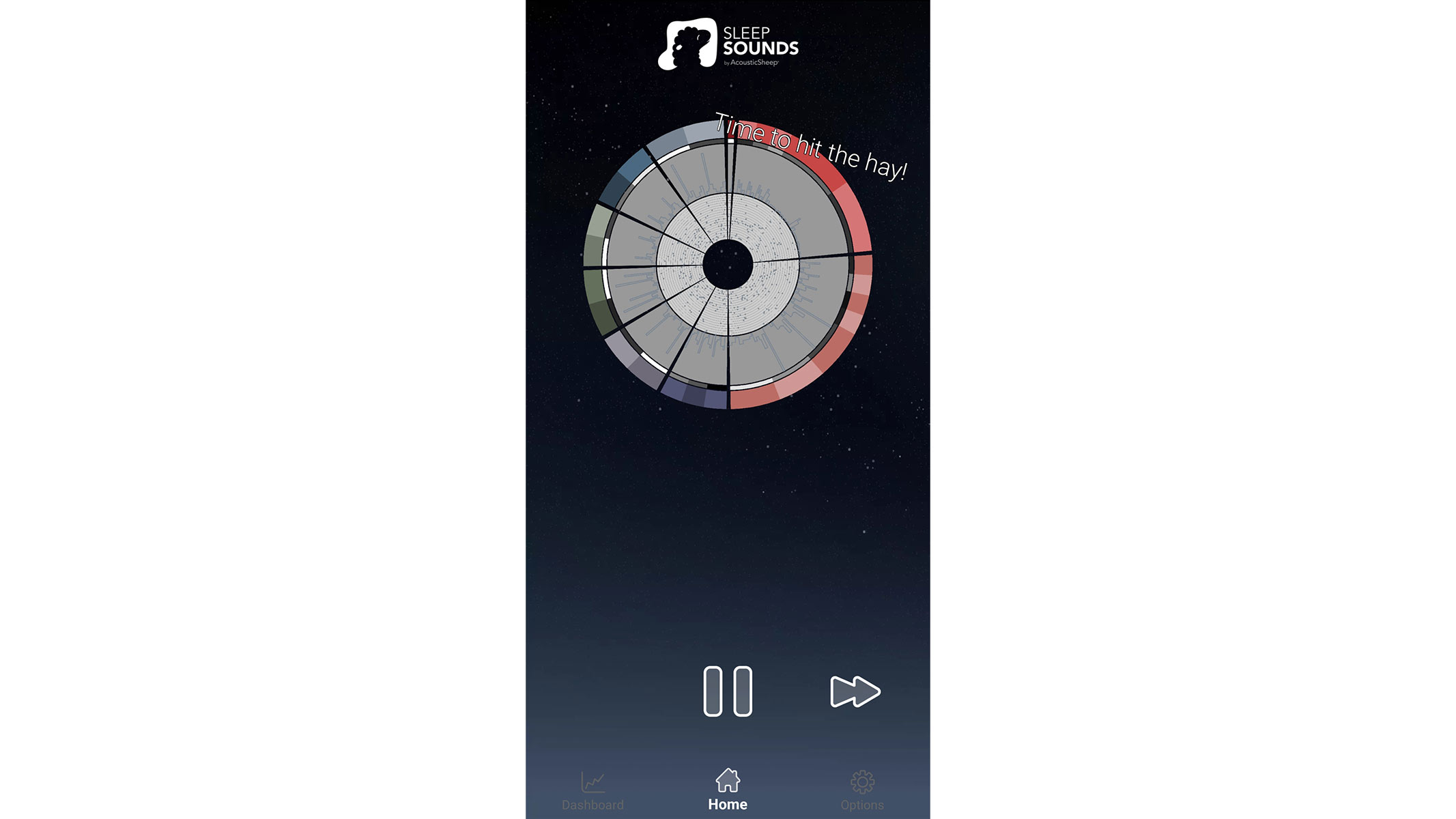
AcousticSheep Wireless SleepPhones V8
Our expert review:
Specifications
Reasons to buy
Reasons to avoid
✅ You are a side sleeper: The wafer-thin headphones will not aggravate your ears.
✅ You want something low-maintenance: The speakers and control unit are easy to move in and out of the fabric headband, and the headband itself is machine-washable and dryer-friendly.
✅ You tend to sleep for long periods: It has the longest battery life of all the sleep headphones we tested.
❌ You are on a budget: These headphones cost $99.95 or $149.95, depending on the charger type.
❌ You sleep in noisy conditions: They are not particularly effective at blocking external sounds and have no active noise cancellation.
❌ You are a restless sleeper: They are bound to shift or slip off if you toss a lot during your sleep.
🔎 AcousticSheep Wireless SleepPhones V8: These snuggly sleep headphones blow the competitors out of the water with their comfortable fit, customizable designs and long battery life. However, they may not suit every type of sleeper, and they are not particularly budget-friendly, either. ★★★★
Earbuds do a great job of blocking out unwanted sounds and lulling you to a peaceful slumber, but many people — for example, side sleepers and those prone to ear pain or ear infections — prefer sleep headphones. These snuggly headbands with built-in headphones tend to be easier on the ears and more comfortable to wear for prolonged periods, plus they can double as sleep eye masks. But, exactly which sleep headphones should you buy? It is difficult to pick that one product that would suit the widest range of individuals, but if we had to, we would give special recognition to the AcousticSheep SleepPhones V8.
Comfort and fit are the two factors that can make or break your experience with sleep headphones, and this is where SleepPhones seem to outshine other products we tested. Most brands make their sleepbands in one size only and use only one type of stretchy fabric. AcousticSheep, on the other hand, offers two different types of fabric — a warmer, plushier Fleece and a lighter, more summer-friendly Breeze — and three different sizes to choose from. You can also choose between five different color options.
We tested the SleepPhones with a Breeze fabric during the summer and were impressed by how snuggly and breathable they felt in warm August temperatures. Also, it is not just the headband that makes these sleep headphones so comfortable. We could barely feel the presence of its wafer-thin speakers on our ears, even when we were sleeping on our side. This sleepband makes you actually want to wear it, rather than just bear with it for the sake of music and podcasts.
The AcousticSheep Wireless SleepPhones V8 sound pretty well, too. Understandably, they are nowhere near as good as the Bose QuietComfort, for example, but their audio quality is still impressive. These sleep headphones will not exhaust your ears with harsh treble, uneven bassline or an imbalanced range of volume.
However, what makes the SleepPhones so great is also what fuels their downsides. While they are highly customizable, choosing the right headband size may feel tricky if your head measurements fall on a size cut-off, and their thin, barely-there speakers will not be able to block out much external noise or stay firmly in place if you toss and turn a lot in your sleep. Lastly, the price. The AcousticSheep Wireless SleepPhones V8 are indeed very well-made, but this also means they cost more than most other sleep headphones — $99.95 for the model with a regular USB charger, and $149.95 with an induction charger.
Attributes | Notes | Rating |
|---|---|---|
Comfort | Snug-fitting and comfortable to wear. Tricky size choices. | ★★★★½ |
Performance | Good sound quality and long battery life. May shift or slip off during sleep. | ★★★★ |
Functionality | Easy to wash and use. No ACL. Limited app functionality. | ★★★½ |
Best budget sleep headphones
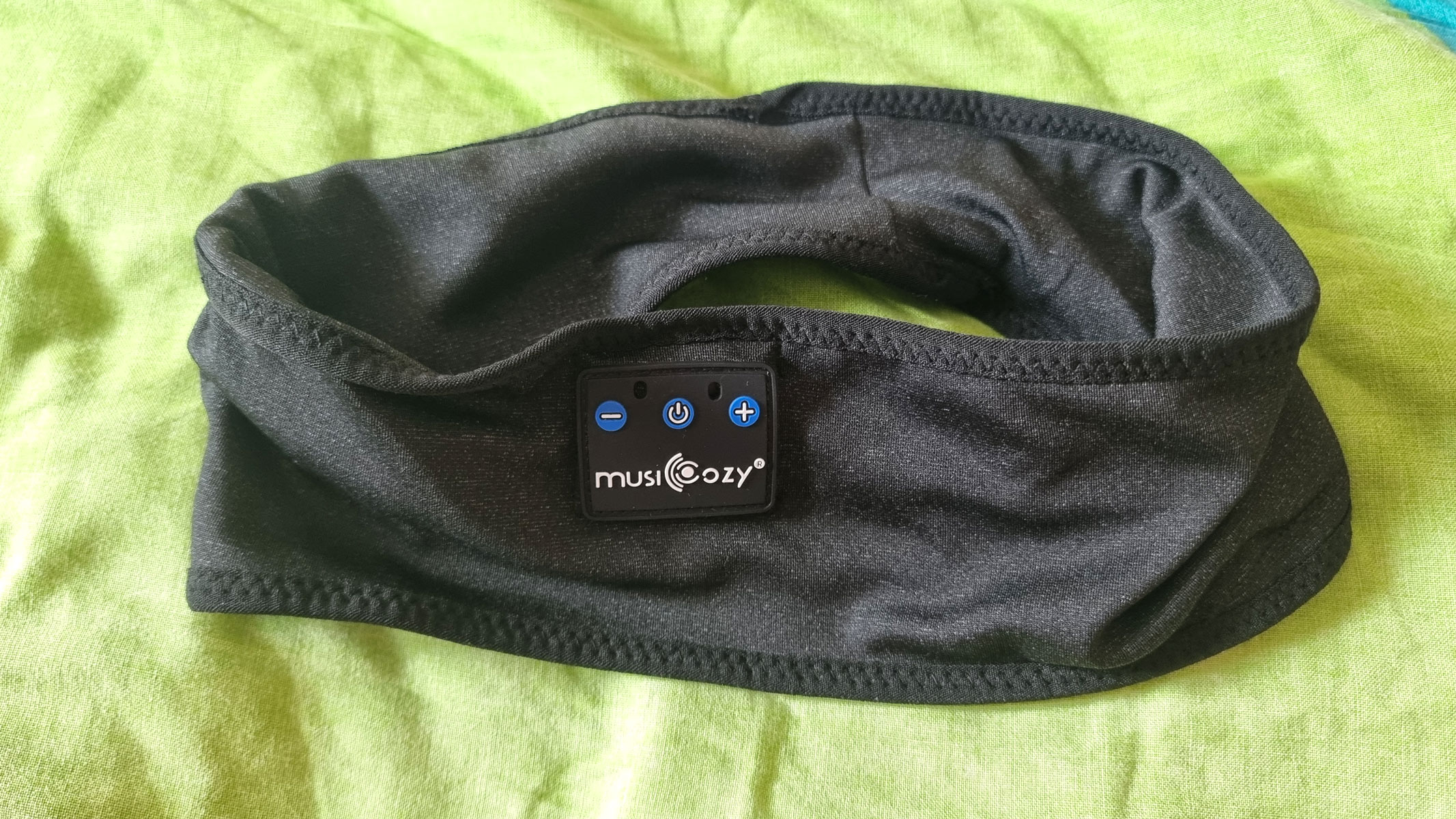
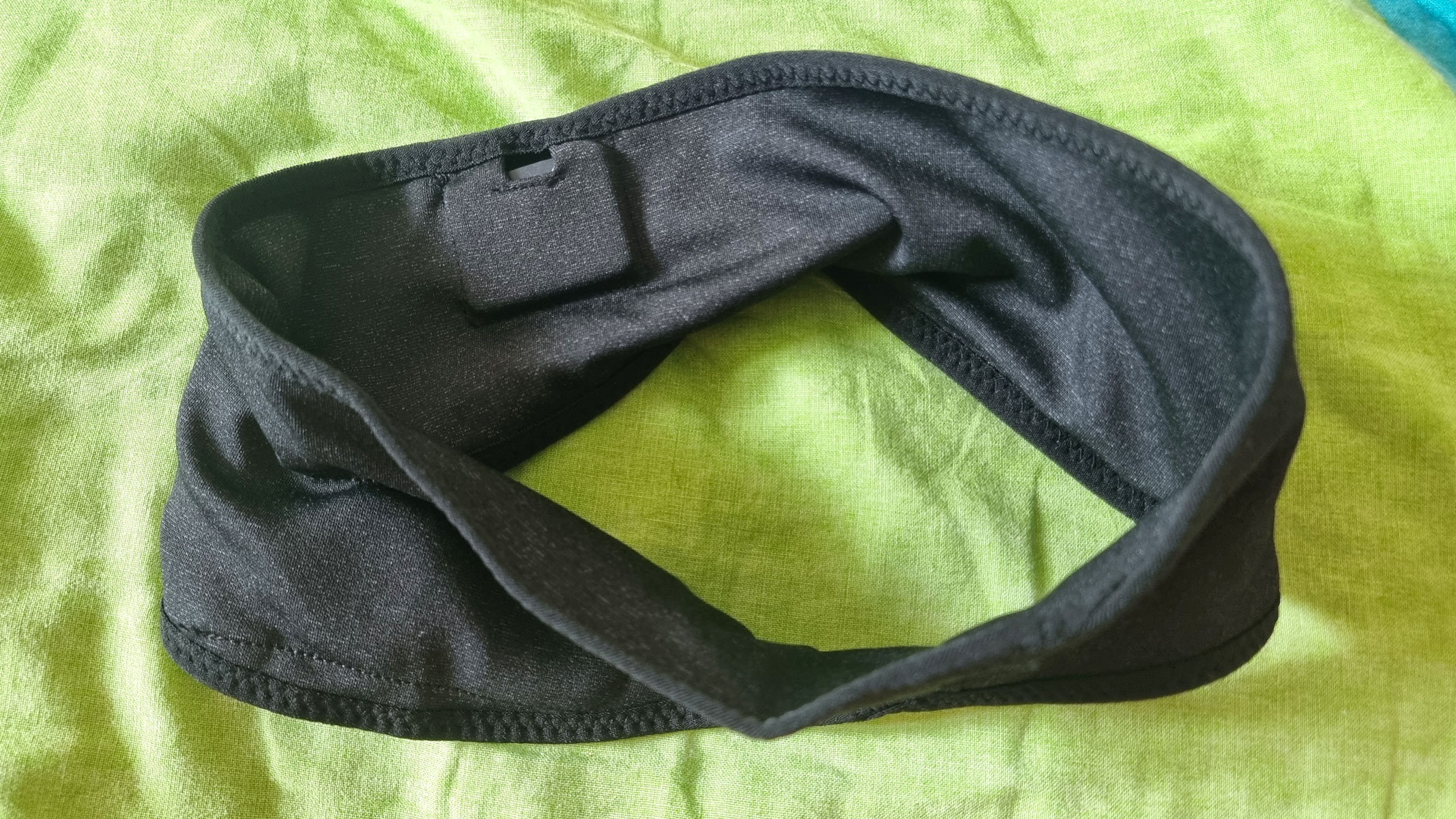
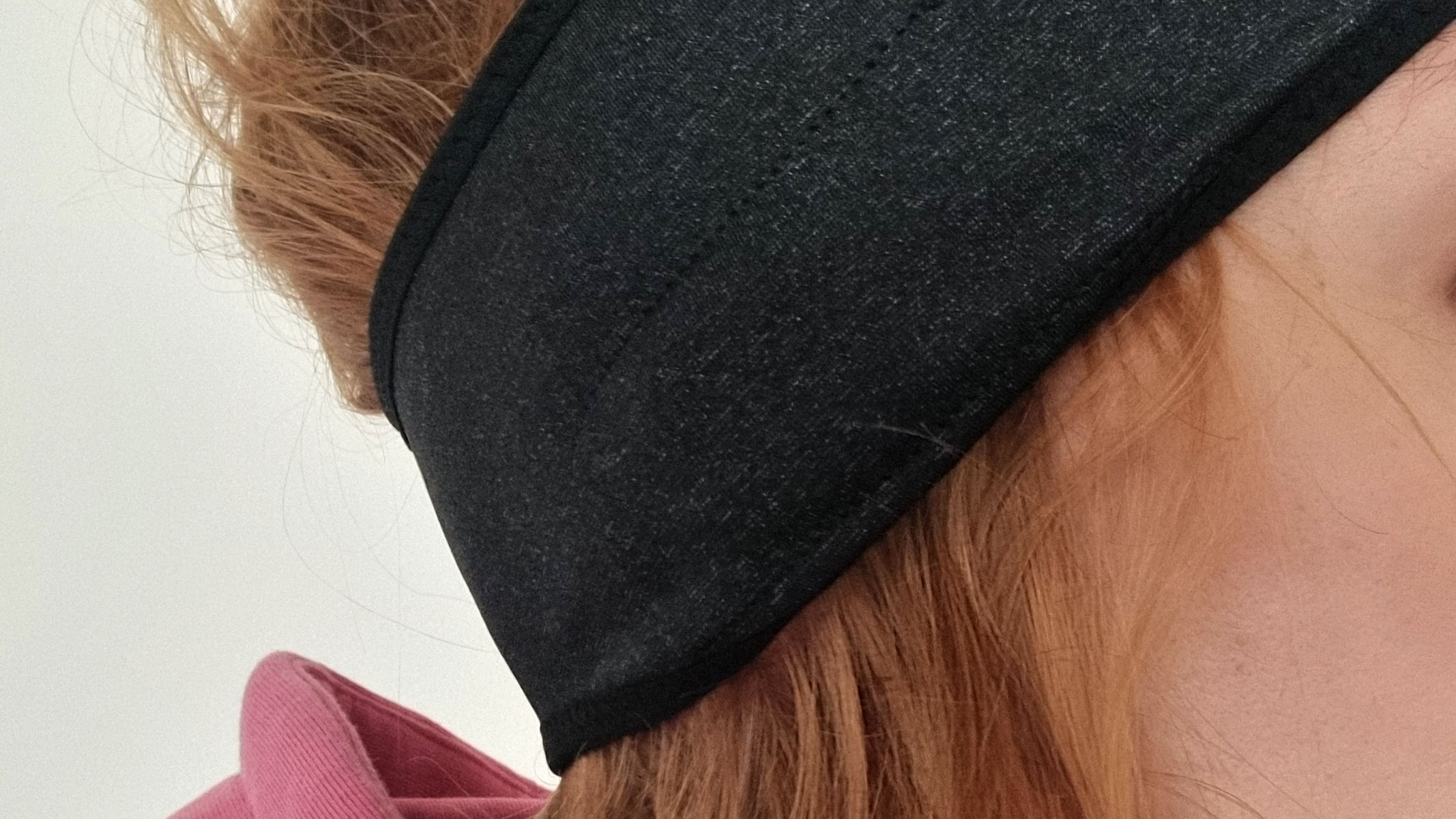
Musicozy Sleep Headphones
Our expert review:
Specifications
Reasons to buy
Reasons to avoid
✅ You are on a budget: It is the cheapest model in this guide.
✅ You prioritize audio quality: The speakers sound surprisingly good for the price.
✅ You do not want to miss your phone calls: It has a built-in microphone.
❌ You want something low-maintenance: The speakers and control unit are difficult to move in and out of the fabric headband.
❌ You want a plush, cozy headband: It is more suitable for daytime activities than sleep.
❌ You like smart features: No connected apps or other frills.
🔎 Musicozy Sleep Headphones: These affordable sleep headphones punch above their budget-friendly price with a built-in microphone, impressive sound quality and relatively long battery life. However, their confusing design and limited customization chip away at their overall value. ★★★½
We gave the AcousticSheep SleepPhones V8 a well-deserved title of the best sleep headphones, but it is hard to deny that it is a premium product that may not suit everyone's budget. If you do not fancy spending nearly a hundred dollars (or more), consider these Musicozy sleep headphones instead — they cost roughly a quarter of what you would pay for the SleepPhones, but their quality is not too far off.
Their biggest advantage is sound quality. This humble-looking headband delivers a surprisingly rich and well-balanced sound and a more extensive volume range than most other sleep headphones we tested. The speakers in Musicozy headphones may not be particularly effective for blocking sounds — they do not have active noise cancellation and are too small to cover the entire ear — but that is what helps make them comfortable to wear. These headphones did not cause us ear soreness, even after side-sleeping for several hours, and the light and breathable headband easily withstood hot summer temperatures.
The built-in microphone is another feature that makes the Musicozy headphones stand out in the budget section. Its audio quality may not match professional headsets, but it is good enough for taking phone calls. If you work jobs that require you to be on a standby during the night, this could be a useful feature for you.
That said, we also had a few major dislikes here. The Musicozy sleep headphones come in one size only, which will inevitably exclude some people. Secondly, the headband can be a real hassle to wash — moving the speakers and control unit in and out of the headband requires a good degree of patience and manual dexterity. Lastly, the fabric can be a hit-and-miss. While it is stretchy and sweat-wicking, and therefore suitable for light exercise and outdoor activities, it lacks the coziness of, for example, the fabric in our SleepPhones.
Attributes | Notes | Rating |
|---|---|---|
Design | Comfortable to wear, but will not suit everyone. Laborsome to wash. | ★★½ |
Performance | Good sound quality and relatively long battery life. | ★★★★½ |
Functionality | Built-in microphone. No connected apps. | ★★★★ |
Best sleep headphones for napping on a plane

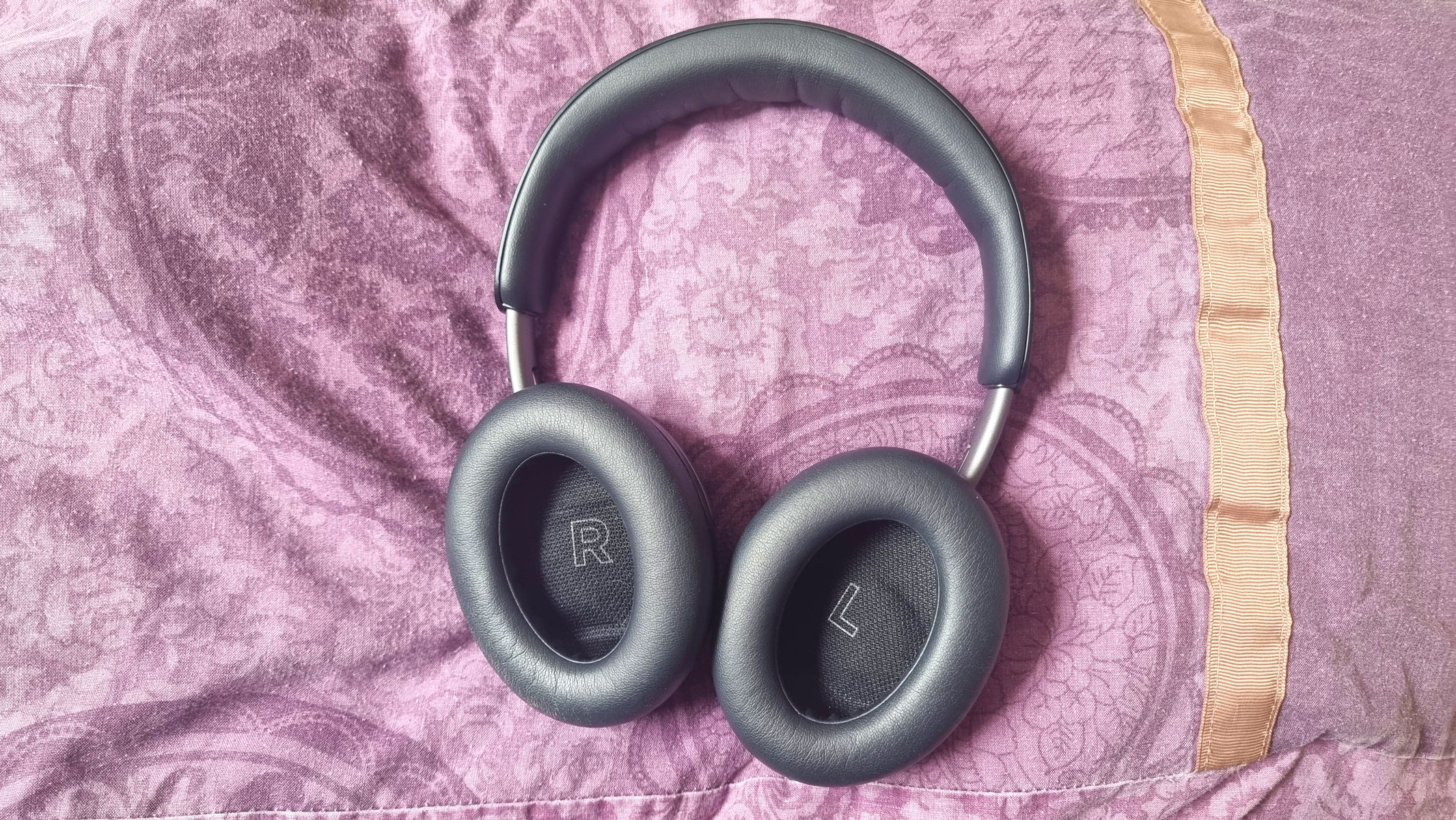
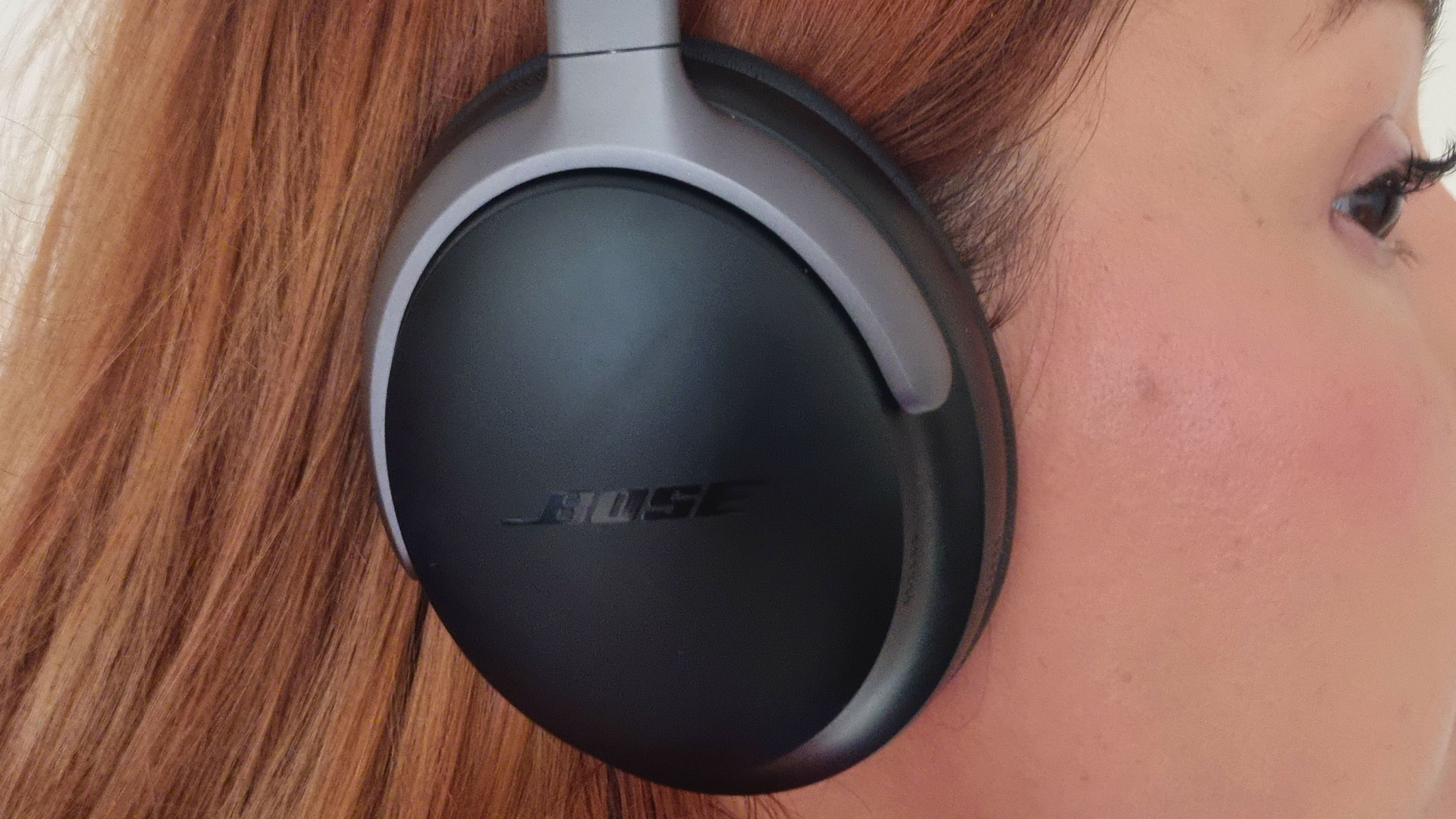
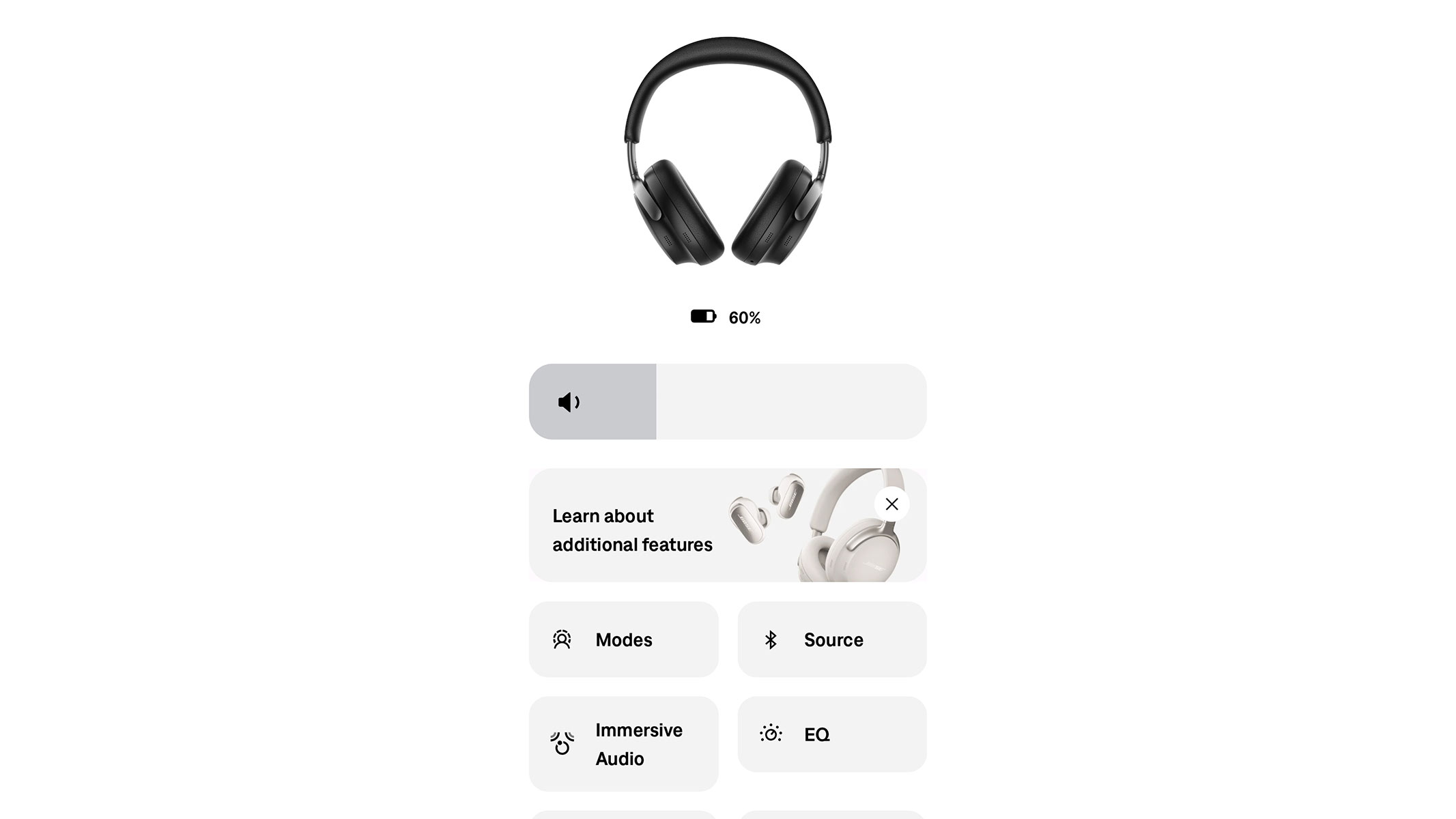
Bose QuietComfort Headphones
Our expert review:
Specifications
Reasons to buy
Reasons to avoid
✅ You are sensitive to engine sounds: These headphones do a good job of canceling continuous low-pitch background noise.
✅ You travel for long hours: They will not cause discomfort or exhaust your ears, even after a whole day of continuous listening.
✅ You are looking for general noise-canceling headphones: They are geared for everyday use.
❌ You are on a budget: Even when on sale, these headphones cost more than $200.
❌ You want something small: They can take up significant space in your carry-on luggage.
❌ You want to sleep through an overnight flight: They are better suited for short naps and daydreaming rather than solid eight hours of sleep.
🔎 Bose QuietComfort headphones: These snuggly headphones deliver a well-balanced sound, top-class noise cancellation features and robust customization settings, making them a great option for music lovers and noise-sensitive individuals. However, they are just a bit too expensive for what they have to offer, and their app connectivity can be patchy at times. ★★★★
Sleeping on a plane is a completely different ball game. Whether you travel in an economy or a first-class seat, the whirring noises of the engine and other flight apparatus will always serve you as a constant reminder that you are trapped in a metal tin thousands of feet above the ground. No wonder then that so many of us love traveling with noise-cancelling headphones. They help us pass the time and take some uninterrupted naps, and unlike the smaller earbuds, bulky headphones will not randomly fall out of your ear into your co-passenger's lap or get lost under the seat.
Our writers' go-to option for sleeping on a plane is the Bose QuietComfort headphones. As their name clearly indicates, they focus on the two aspects that are critical for comfortable air travel: snuggly fit and effective noise cancellation. We have worn our Bose QuietComfort on multiple flights, both short and long, and we have never experienced ear irritation, pressure headaches or 'listener fatigue' (a state of mental exhaustion caused by listening to something for prolonged periods). On the contrary, these headphones always felt pleasant and comfortable to wear even after a long day of traveling. The Bose QuietComfort headphones also do a fabulous job of blocking out low-frequency sounds. The aforementioned whirring of a jet engine, for example, can be effectively wiped out by its top-class active noise cancellation features.
We also appreciate its great sound quality. True, the Bose QuietComfort headphones have a slight tendency to emphasize bass, and their ANC mode can sometimes introduce a faint background noise, but this is more of a niggle than a serious complaint. Besides, you can always customize your audio settings in the designated Bose app.
We only have two gripes with these headphones: the $359 price tag and their patchy app connectivity. They are just a bit too expensive for what they have to offer, and connecting them to the Bose app can be an uphill battle for no apparent reason.
Attributes | Notes | Rating |
|---|---|---|
Design | Ultra-comfortable to wear. Not suitable for exercise. Takes up significant amount of space in hand luggage. | ★★★★ |
Performance | Good sound quality and effective ANC. Patchy app connectivity. | ★★★★ |
Functionality | Useful app. Good range of volume and movement detection. | ★★★★ |
Best alternative to sleep headphones
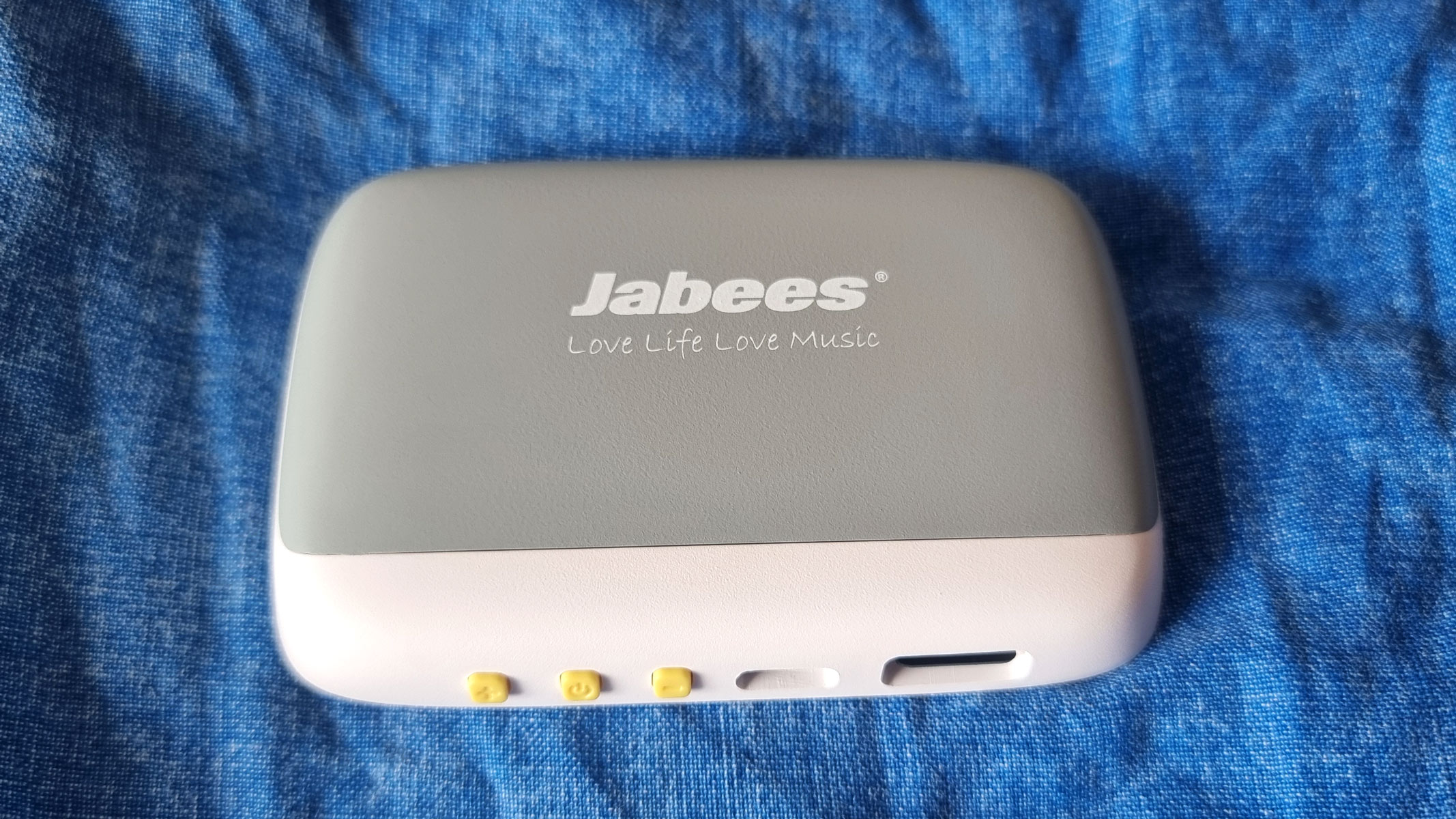
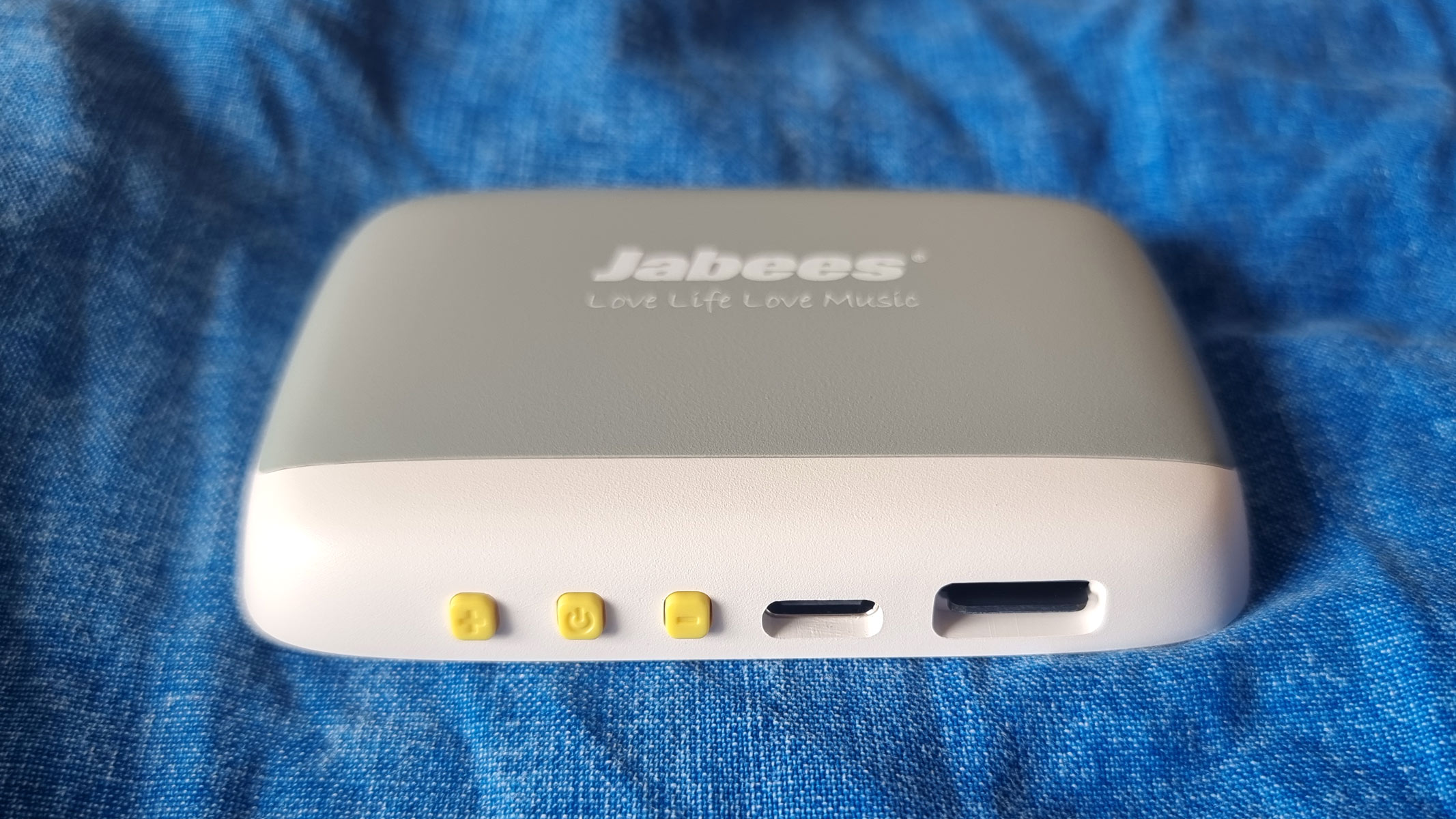
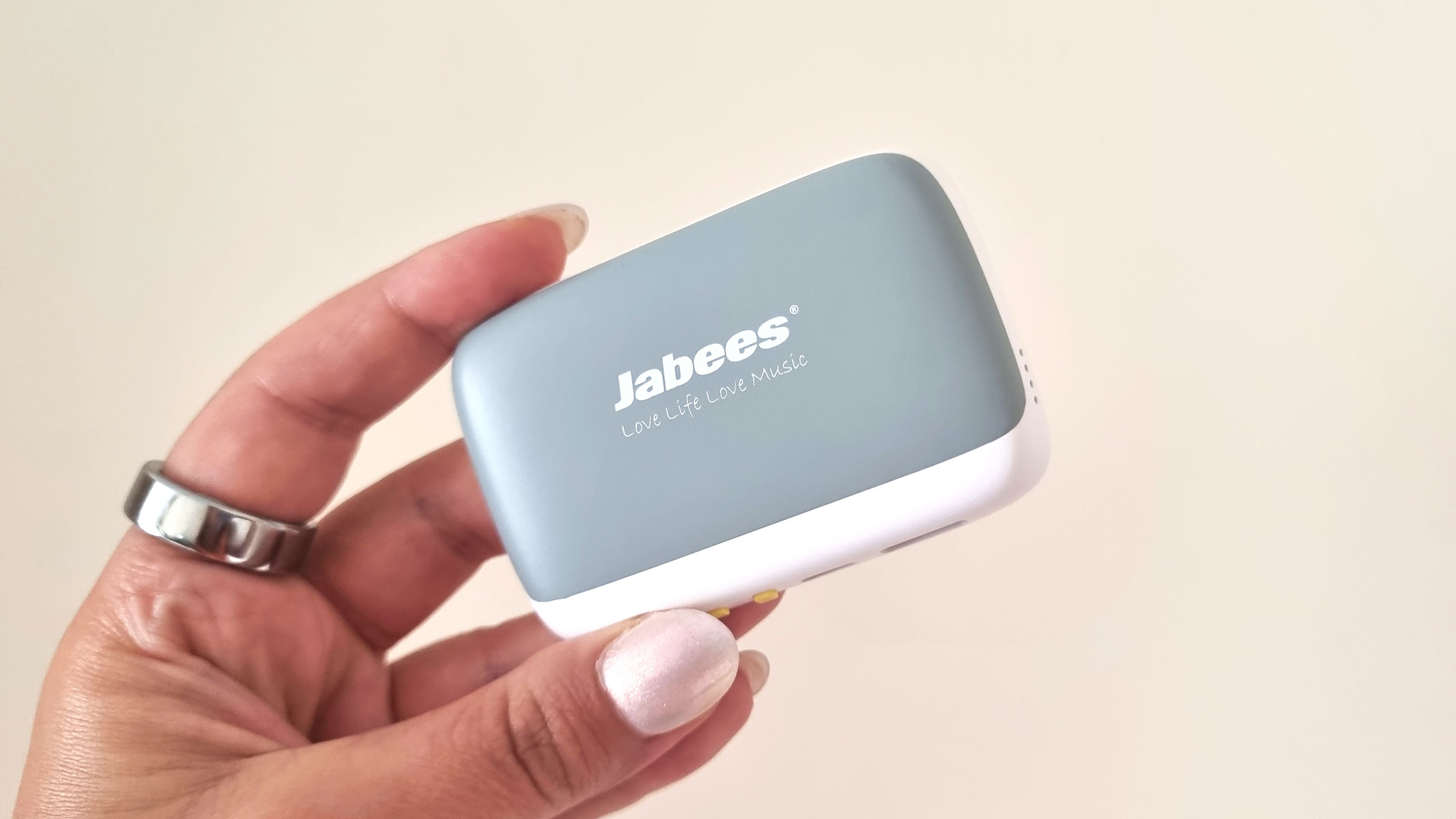
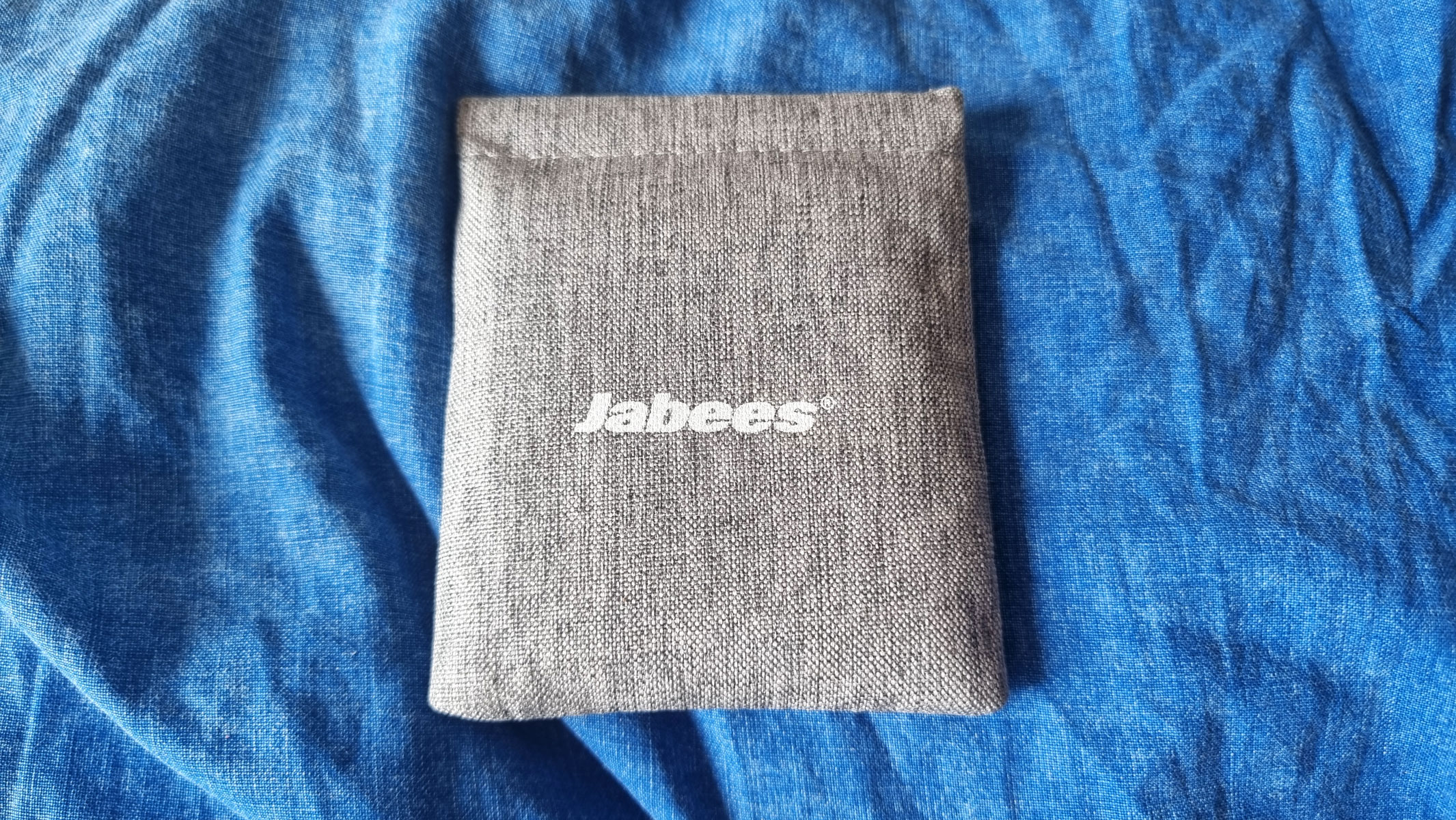
Jabees Peace Pillow Speaker
Our expert review:
Specifications
Reasons to buy
Reasons to avoid
✅ You need to stay aware of your surroundings: It does not cancel noise.
✅ You are sensitive to headphones: It will not aggravate your ears.
✅ You are on a budget: It costs less than $40.
❌ You are an audiophile: Bone conduction tends to work better for podcasts and audiobooks than music and complex soundscapes.
❌ You share your bed: It may accidentally wake up the other person.
❌ You are a restless sleeper: The speaker can shift with your movements.
🔎 Peace Pillow Speaker: A great alternative to sleep earbuds and over-ear headphones, this tiny bone conduction speaker will not aggravate your ears, disturb others, or drain your wallet. ★★★★½
Headphones and earbuds do a great job of cancelling noise and sending you to a peaceful sleep, but that does not work for everyone. For example, parents with small children, hospital visitors or people travelling on sleeper trains may want to get some shuteye while still staying aware of their surroundings. Individuals with very sensitive ears or suffering from tension headaches may also be against using sleep headphones. So, what should you do if you are not keen on wearing a headset every night? We would recommend the Jabees Peace Pillow Speaker.
This little device uses bone conduction technology, meaning it does not rely on air to transmit the sounds like the 'regular' speakers do. Instead, it uses the vibrations in your skull to transmit the sound waves directly to your inner ear. Sounds scary? Not at all. Bone conduction is a safe technology, widely used in hearing aids and open-ear headphones used by outdoor runners. True, the sound quality on bone conduction devices is never too impressive, but it is still good enough to send you off to sleep with a podcast, audiobook or basic soundscapes.
What we liked most about the Jabees Peace is its functionality. For example, this speaker is exceptionally travel-friendly. It weighs only 1.59 oz (45g) and measures just 3.39 inches in length and 2.28 inches in width (8.6 and 5.78 cm, respectively). You can take it almost anywhere, and it lasts up to 10 hours on a single charge. Plus, you can barely feel it under the pillow. Lastly, the Jabees Peace features an optional SD card with eight pre-loaded soundscapes, so it can also be used as a white noise machine.
However, pillow speakers have one major disadvantage — they can easily shift around. They may not be the best idea for you if you toss and turn a lot in your sleep, or if you share your bed. Little devices like that can inadvertently wake up or disturb your partner if they accidentally move onto their side.
Attributes | Notes | Rating |
|---|---|---|
Design | Light, pocket-sized and travel-friendly. | ★★★★½ |
Performance | Acceptable sound quality. No noise cancellation. | ★★★★ |
Functionality | Suitable for a wide range of individuals. Built-in white noise machine. | ★★★★½ |
Second-best alternative to sleep headphones
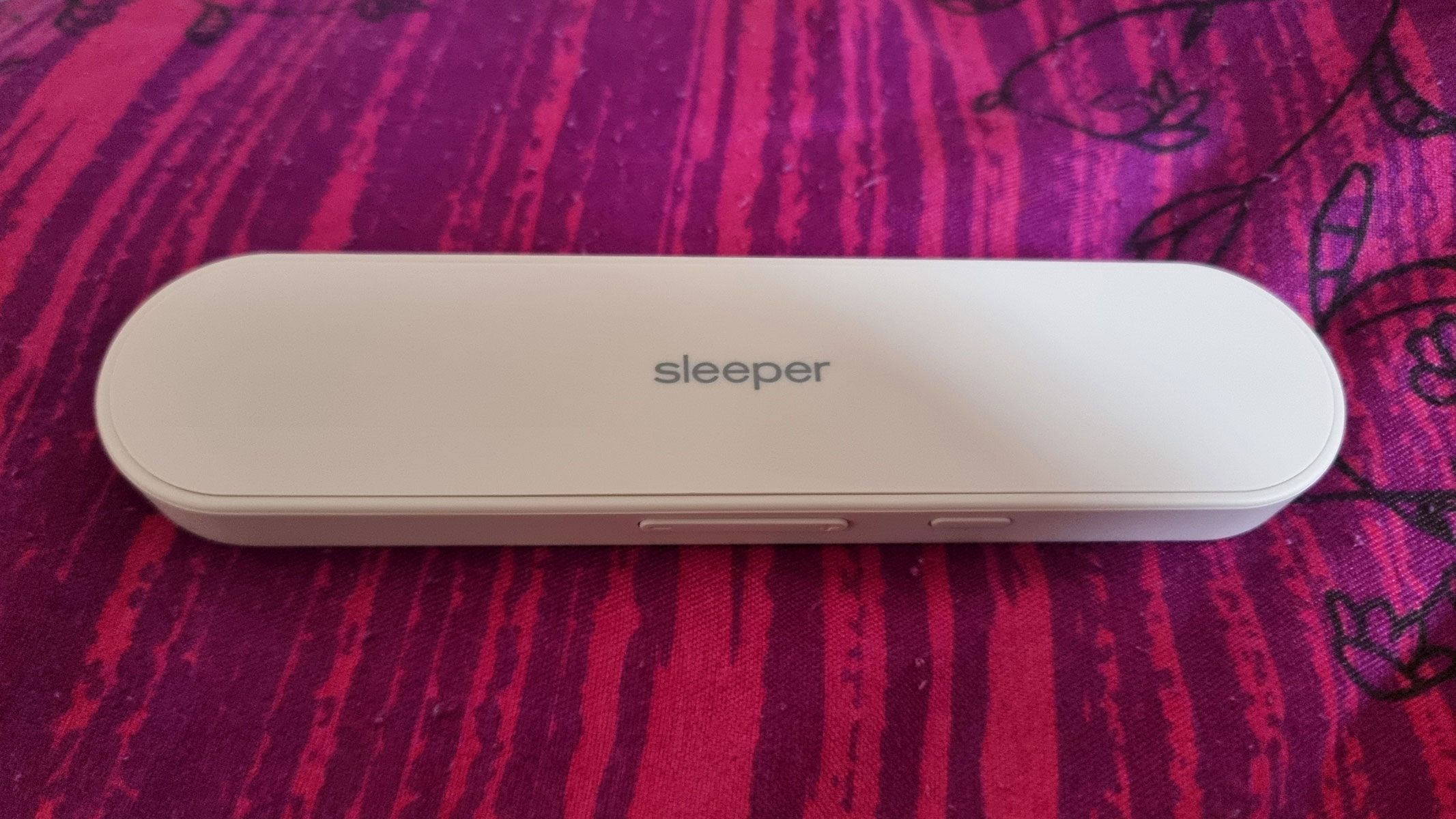
The Advanced Sounds Sleeper Speaker is another great alternative to sleep headphones. While it is slightly longer and thicker than the JabeesPeace Pillow Speaker mentioned before, it is just as sleek, unobtrusive and well-built, and it comes with eight hours of battery life and MicroSD compatibility. That said, we found the sound quality on the Sleeper Speaker to be rather mediocre, and we did not like that it did not have intuitive button controls and indicator lights.
Pros
- Sleek, unobtrusive design
- Good build quality
- 8 hours of battery life
Cons
- Sound quality could be better
- No indicator lights
- Some sound leakage
Best sleep headphones: comparison
Product type | Rating | Style | Noise cancellation | Battery life | Connection type | Alarm |
|---|---|---|---|---|---|---|
Ozlo Sleepbuds | ★★★★½ | Earbuds | Passive | 10 hours | Bluetooth LE | Yes |
Soundcore Sleep A30 | ★★★★ | Earbuds | Active | 9 hours | Bluetooth 5.3 | Yes |
AcousticSheep Wireless SleepPhones V8 | ★★★★ | Headband with headphones | Passive | 24 hours | Bluetooth 5.0 | No |
Musicozy Sleep Headphones | ★★★½ | Headband with headphones | Passive | 14 hours | Bluetooth 5.4 | No |
Bose QuietComfort | ★★★★ | Over-ear headphones | Active | 24 hours | Bluetooth 5.1 | No |
Jabees Peace Pillow Speaker | ★★★★½ | Bone conduction speaker | N/A | 10 hours | Bluetooth 5.3 | No |
Contributing experts & product testers

Anna Gora is a health writer, certified personal trainer, nutritionist and health coach with over 12 years of professional experience. She holds a Bachelor's degree in Nutrition from the Warsaw University of Life Sciences, a Master’s degree in Nutrition, Physical Activity & Public Health from the University of Bristol, as well as various health coaching certificates. Anna is also an audiophile and music lover, and has personally tried and tested all the sleep headphones in this guide.

Dr. Ross Cushing, Au.D. is a clinical audiologist with over 20 years of professional experience and the founder and CEO of Live Better Hearing + Balance, a chain of hearing clinics based in the Mid-Atlantic region. He told Live Science about the potential effects of sleep headphones on our ear health and sense of hearing, and advised on the best types of music to listen to while falling asleep.

Dr. Jonathan Webster is a general practitioner with over 30 years of professional experience. He obtained his medical degree at the University of Otago in New Zealand in 1992. Several years later, he relocated to the United Kingdom, where he has since been practicing as an accredited GP for the National Health Service. For this piece, Jonathan discussed the pros and cons of using headphones and earbuds for improving sleep and managing sleep disorders.

Shaun O’Brien is the founder of Selby Acoustics, an Australian online retailer of home audio equipment. He has amassed extensive knowledge in speakers, headphones, and other sound devices over 40 years of retail experience. For this piece, Shaun explained the difference between active and passive noise cancellation, commented on the sound quality of sleep headphones, and shared his advice on how to choose the best product.

Kenny Timper is a certified sleep coach and staff writer at Mattress Clarity, a website specializing in reviewing mattresses, bedding and other sleep accessories. He commented on the potential positive and negative effects of using sleep headphones on sleep quality, and shared his tips on how to choose the best product.

Bogdan Bratis is a musician, entrepreneur and the founder of Saspod, a podcast production company based in Glasgow, Scotland. He obtained his degree in popular music production at Southampton Solent University and worked on multiple sleep audio projects, including for the Deep Meditate app. For this piece, Bogdan commented on the differences between active and passive noise cancellation, the sound quality of sleep headphones, and the potential effects of prolonged loud music on our sense of hearing.

Sam Sadighi is a psychologist, certified sleep practitioner and the founder of Easy Sleep Solutions, an online sleep coaching service based in the United Kingdom. She specializes in cognitive behavioral therapy for insomnia and other sleep disorders. Sam discussed whether sleep headphones can help manage sleep disorders and improve overall sleep quality.
Best sleep headphones: Frequently Asked Questions
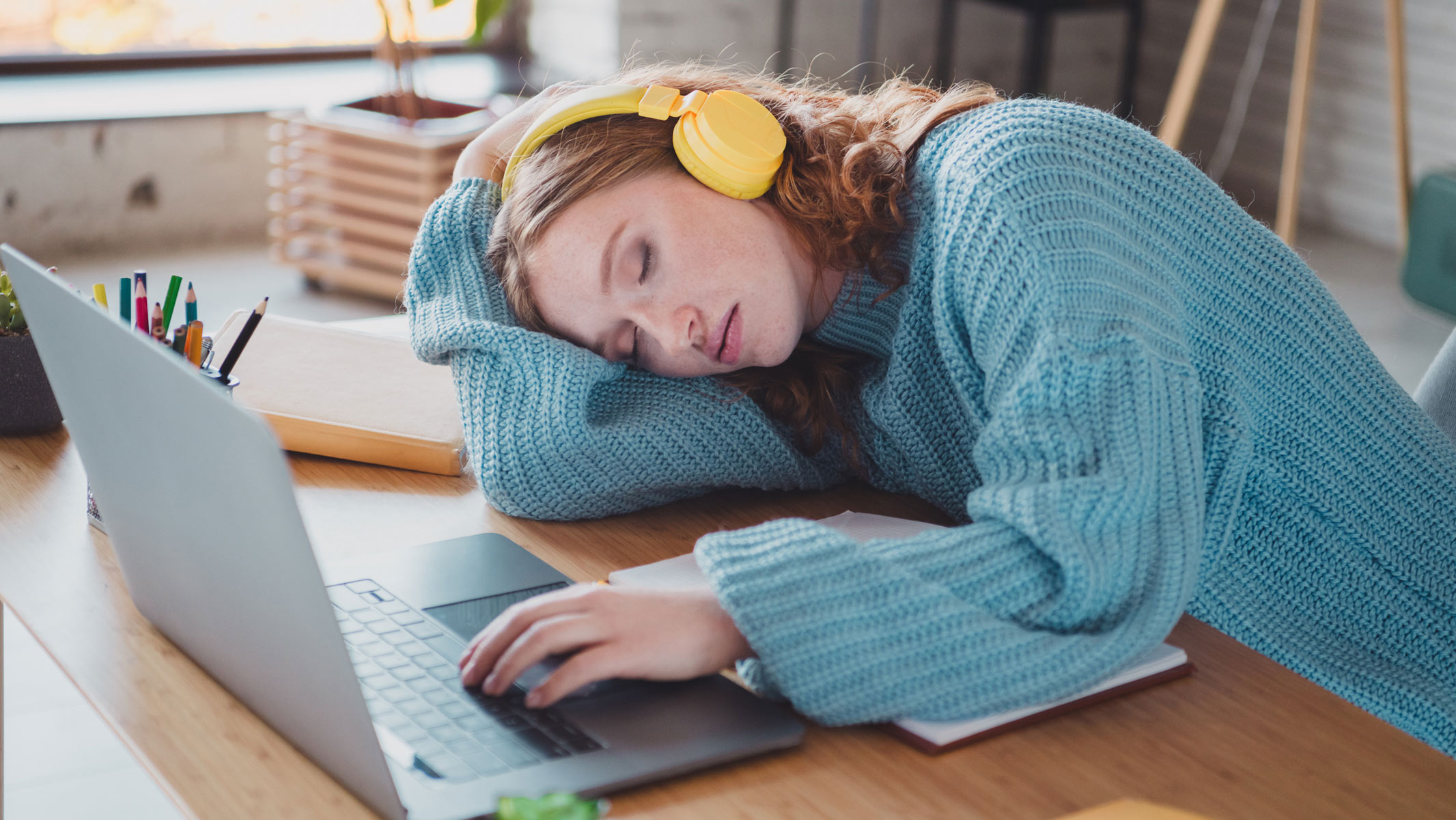
What is the difference between active and passive noise cancellation, and which is better for sleep?
In short, passive noise cancellation (PNC) physically stops the sound from entering your eardrums, while active noise cancellation helps cancel out incoming sounds by creating sound waves that counteract them, Bogdan Bratis, a musician, audio expert and podcast producer based in Glasgow, Scotland, told Live Science.
"In headphones with passive noise cancellation, we use materials with noise-cancelling properties to block the sound from getting through. In headphones with active noise cancellation, on the other hand, external sound gets captured by a microphone situated somewhere in the headphones' body and then either cancelled or reduced in intensity due to what we call in audio 'destructive interference.' The best way to visualise this phenomenon is in water. When throwing two similar-sized stones in a lake at the same time, the waves resulting from these two stones will clash, cancelling each other out. This exact phenomenon happens in audio," Bratis explained.
Which is better for sleep: ANC or PNC? It largely depends on where and how you intend to use your headphones. "Passive noise cancellation is generally more useful. Active noise cancellation may sound fancy, but it can be overkill for sleep," Shaun O’Brien, the founder of Selby Acoustics and audio retail expert based in Australia, told Live Science.
Generally, ANC is more energy-intensive than PNC. It also tends to introduce faint white noise that many people find disruptive. "Active noise cancellation works best with steady external sounds like engine hum or fans. If your room is already quiet, the ANC just drains battery. So, if you do not have highway noise or loud neighbors, I suggest you skip it," O'Brien said.
Can sleep headphones improve the quality of your sleep?
Again, it depends. Sleep headphones can indeed help you fall asleep faster and achieve a better quality of sleep, but they can also have the opposite effect if they are uncomfortable or ill-fitted, Kenny Timper, a certified sleep science coach and an expert reviewer of mattresses and other sleep accessories, told Live Science.
"Blocking outside noise with sounds can help quiet your brain and reduce distractions, which makes it easier to fall and stay asleep. Sleep headphones can be especially helpful if you live in a noisy area or your mind tends to race at night. For some people, consistent white noise throughout the night keeps them from waking up," Timper said.
However, sleep headphones can also be overly stimulating. "If they press into your ears, you might wake up from discomfort or toss and turn more. Some people also find they get too warm wearing them all night. If they keep shifting or the sound is too aggravating, that can pull you out of deeper sleep stages," Timper explained.
Can sleep headphones help manage sleep disorders?
Yes, sleep headphones can help manage insomnia, anxiety-related sleep difficulties, noise sensitivity and even tinnitus (ringing in the ears), Dr. Jonathan Webster, an England-based general practitioner, told Live Science. "There are several reasons: sleep headphones mask disruptive sounds, such as snoring, traffic noise or barking pets; they provide consistent, soothing auditory input which can trigger the brain’s relaxation response; they help shift attention away from racing thoughts or external disturbances, and lastly, they stimulate parasympathetic nervous system activity ["rest and digest" activities], which promotes relaxation and sleep onset," Webster explained.
That said, our experts agree that sleep headphones are not a substitute for professional health advice and clinical treatment. "They are not a cure and will not address the root causes of insomnia. It is best to use them as a short-term aid while building longer-term sleep strategies, such as improving their wind-down routine, addressing thought patterns, and setting up an environment more conducive to rest," Sam Sadighi, a psychologist and certified sleep practitioner based in the United Kingdom, told Live Science.
Is it safe to sleep with headphones on?
Generally, yes, as long as the headphones are comfortable and the volume is set low, Dr. Ross Cushing, Au.D., a clinical audiologist and the founder and CEO of Live Better Hearing + Balance hearing clinics, told Live Science. "Your ears need rest, too. It is best to keep the volume low enough that you can hear it, but not so loud that it feels like you are in the front row at a Metallica concert," Cushing said.
That is because playing sounds through headphones for long periods can cause a Temporary Threshold Shift (TTS), a phenomenon that makes us lose the ability to hear higher sound frequencies after being exposed to continuous loud noises, Bratis said. "We often experience TTS when attending a concert or a loud restaurant. It is temporary; however, experiencing TTS repeatedly could eventually develop into Permanent Threshold Shift (PTS), which would affect your hearing permanently," he said.
Ear health is another important factor. "Sleep earbuds are safe to use, but they carry a risk of earwax buildup, irritation, or ear canal infections, as well as potential pressure on the ear if sleeping on your side. Sleep headphones are generally safer than earbuds for overnight use, particularly for side sleepers or with prolonged use," Webster said.
To minimize the risk of ear infections, use a damp alcohol-based wipe (such as a lens wipe, for example) to sanitize your sleep earbuds when you wake up in the morning, Timper told Live Science.
Is sound quality important for sleep headphones?
Our experts agree — the sound quality of sleep headphones is not as good as that of regular headphones. The reason for that is quite pragmatic. "Sleep-specific models lean toward functionality. Most of them have 6 mm drivers or smaller [small speakers inside headphones that convert electrical signals into sound waves], which inevitably limits their audio dynamics," O'Brien said.
This poor sound quality should not be viewed as a deal-breaker, though. "You do not want booming bass shaking your skull at 3 am. A flat frequency response with no harsh treble is better for sleep than studio-grade accuracy," O'Brien said. Moreover, most people use sleep headphones to play background noises, such as white noise or natural soundscapes, and these play similarly on both sleep and regular headphones anyway, Bratis noted.
What sounds are best for sleeping?
It all depends on personal preference. That said, certain sounds tend to be more conducive to good sleep than others. Unsurprisingly, slow and calming sounds tend to perform better than fast-paced music, Cushing said. He recommended brown noise and natural soundscapes, such as raindrops hitting the ground or ocean waves crashing on the shore. "Your brain loves patterns, and these sounds will help drown out random external noises and ease you into a deep sleep," Cushing explained.
Binaural beats — an auditory illusion in which two different tones are each played in one ear, creating a third perceived tone at the difference frequency — could also be helpful. "I have not seen studies supporting the use of binaural beats, but they are supposed to help mimic your calm brainwaves, and many people find them very relaxing," Cushing said.
Low-tempo instrumental music, pink noise and guided meditations can also be beneficial, and some people even like falling asleep to boring podcasts, Sadighi said. "Funnily enough, there are some podcasts specifically designed to induce sleep by discussing mundane topics. The main goal here is to avoid any content that is stimulating or emotionally engaging," she explained.
"Ultimately, consistency and familiarity with your chosen sound, ideally something you already associate with winding down, are key to promoting restful sleep," Sadighi concluded.
How to choose the best sleep headphones for you
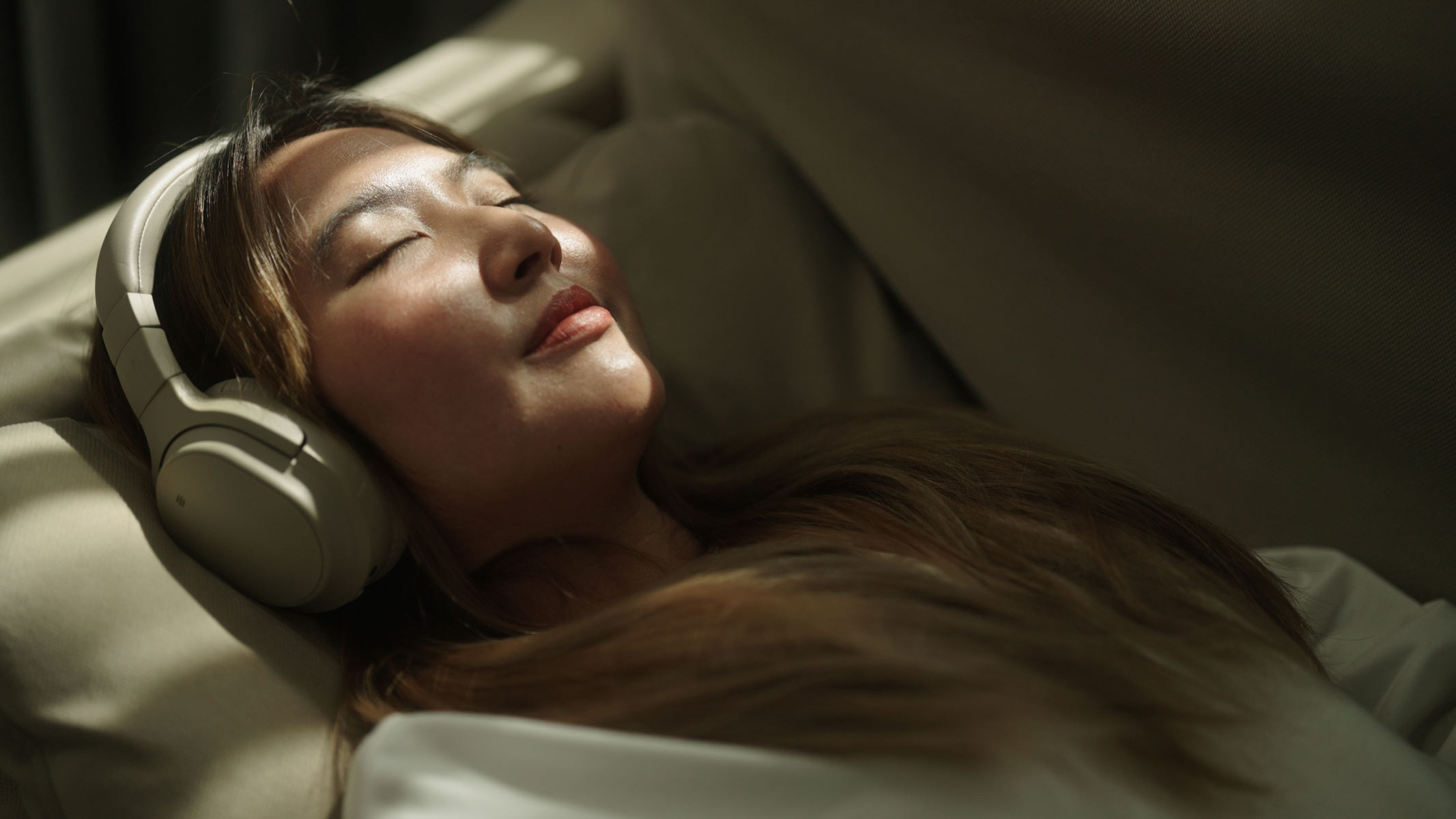
Our experts agree — choosing the right sleep headphones should largely depend on your needs, sleeping habits and ear sensitivities, and less so on the sound quality or the looks of the device. "Sleep headphones do not need to match the audio standards of premium music headphones. What matters more is comfort, battery life, and the clarity of the audio used to support sleep," Sadighi said.
The first step is to decide between earbuds and over-ear headphones. Each type has its pros and cons, and many people use them interchangeably depending on the circumstances and the intended effect. "It is really personal preference," Cushing said, "but if I had to choose one, I would go with the over-ear headphones because they are less likely to cause soreness in your ears or earwax buildup." O'Brien agreed and added, "I have seen more complaints on sleep earbuds due to ear infections and discomfort than in almost any other headphone category."
Headphones also tend to be more comfortable for side sleepers. "Earbuds can work well if they are soft and low-profile, but they are more likely to cause discomfort or fall out," Timper said. Another perk of sleep headphones is that they can also serve as sleeping masks.
On the other hand, over-ear headphones do not tend to stay in one place during the night. "The headbands are a good idea, but only when the speakers are wafer-thin and sit flush. If the headband is too warm, you sweat through your pillowcase. If the headband is too loose, it slips," O'Brien said. To make matters worse, many headbands are available in one size only. Moreover, the vast majority of sleep headphones can only be recharged with a plugged cable, whereas most earbuds can charge up their battery while sitting in portable cases.
Whichever type you choose, make sure your sleep headphones do not have any wires. "A wired headphone set that gets tangled while you toss and turn in your sleep can pose a safety risk," O'Brien said. Not to mention, it is simply unpleasant to sleep with cables rolling around your head and neck.
So, which sleep headphones should you choose? "Ultimately, it comes down to your sleep position and what feels best for your body," Timper said.
Latest updates
December 12, 2025: We added the Advanced Sound Group Pillow Speaker as the second-best alternative to sleep headphones. August, 2025. The guide was first published.
How we tested these sleep headphones
How we test the best sleep headphones






Sleep headphones are difficult to test objectively, and not just because they come in all shapes and sizes. While some models can work wonders for one's sleep, it is not guaranteed that they will have the same effect on other people. Different individuals have different ear shapes, hearing sensitivities and ideas as to what constitutes good, restful sleep. Therefore, we went to great lengths to ensure that all sleep headphones in this guide were tested to the exact same standard and judged in a fair and balanced manner. After spending at least three nights with each device, we ranked it across the following categories:
Design. We look into the shape, weight and fit of the headphones, assess how comfortable they feel in different sleep positions, and give our verdict on their ease of use (particularly during the night) and durability.
Functionality: Simply put, we check what this product can actually do. We want to know how extensive its volume settings and sound modes are, whether it comes with any dedicated apps and/or sleep-focused features, and, if applicable, if it can be effectively used for activities other than sleeping (for example, studying or working out).
Performance: We assess the product's battery life, sound quality and app connectivity (if applicable) and note whether the headphones appear to have a specific effect on our sleep duration and/or sleep quality.
We then weigh these three factors against the price of the sleep headphones in question, and give a final score out of five.
Get the world’s most fascinating discoveries delivered straight to your inbox.

Anna Gora is a health writer at Live Science, having previously worked across Coach, Fit&Well, T3, TechRadar and Tom's Guide. She is a certified personal trainer, nutritionist and health coach with nearly 10 years of professional experience. Anna holds a Bachelor's degree in Nutrition from the Warsaw University of Life Sciences, a Master’s degree in Nutrition, Physical Activity & Public Health from the University of Bristol, as well as various health coaching certificates. She is passionate about empowering people to live a healthy lifestyle and promoting the benefits of a plant-based diet.


